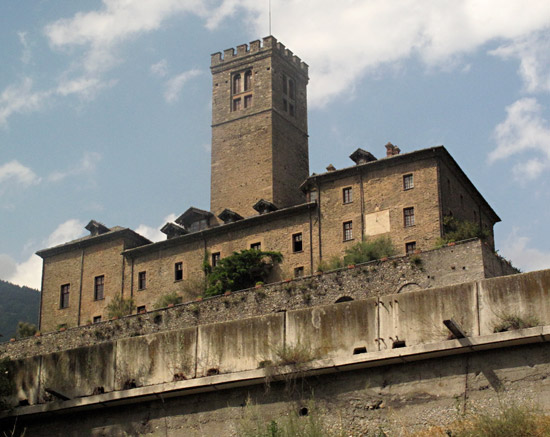
by Maureen | Jul 24, 2010 | Aosta, Incredible Locations, Journal, Photo of the Day, Photos
On Thursday, the bus pulled away from a 95 degree day in Milano and headed into increasingly blustery skies in the Valle d’Aosta at the far northwest of Italy. (Find it on the map here.) I shot a few crude images through the dirty, tinted bus window as we rolled along, watching the scenery and the weather change. We went from the corn fields surrounding Milano, to castles and mountainside vineyards.
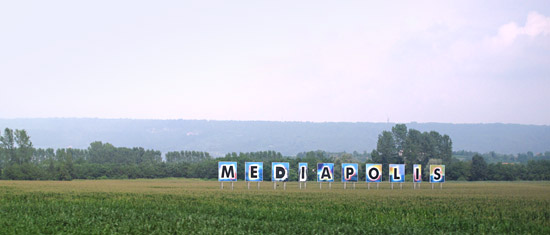
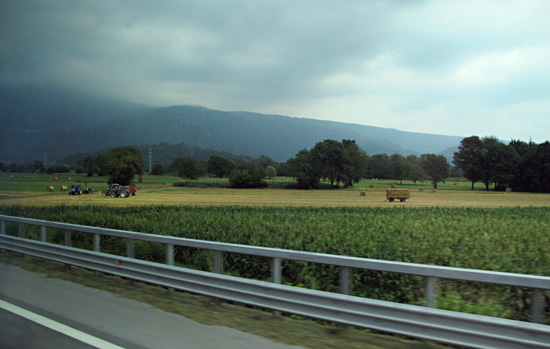
Today, two days later, on my return trip home from Cogne, the weather had changed and I sat on the north side of the bus to be out of the heat of the sun.
– – –
Some notes from my journal entries to-and-from:
22 Luglio, 1:00
Milano – Lampugnano. (One of the metro stops on the red line and a major bus transfer point).
Heading west to Aosta and Cogne to spend a couple of days with Ewa and Piotr. They were my first new friends here and I will say my goodbyes to them as they’re spending this month in the mountains.
The bus has just pulled away from the station.
From Aosta, I could throw a rock north into Switzerland or west into France. I could pitch it to the top of Mont Blanc. Great to have this opportunity to see another spot in Italy, one of its mountainous regions. This is part of my “Say Yes!” program: say “yes” to what presents itself.
(Late in the ride, this is the closest I got to a view of Mont Blanc, obscured by clouds.)
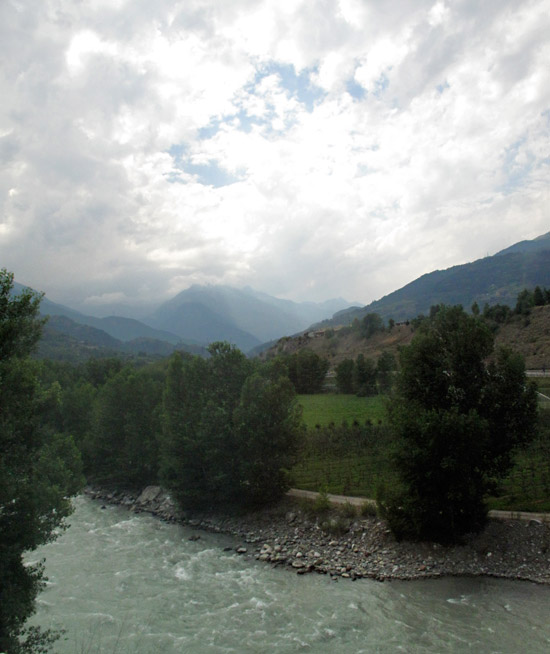
2:30
As we head deeper into the Valle d’Aosta, the proximity to Switzerland is apparent. The architecture has changed. Rooftops bear flat, gray slate instead of red tile.
(This very old rooftop has lost its distinctive fish-scale pattern as the slate has broken up.)
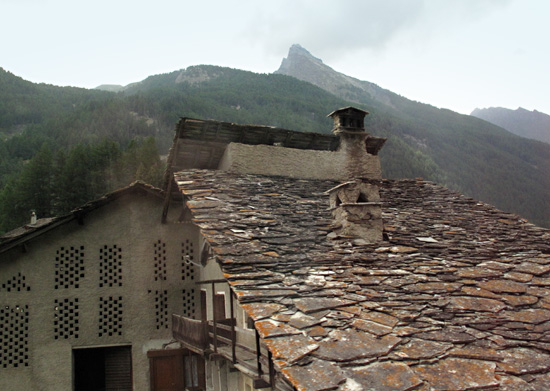
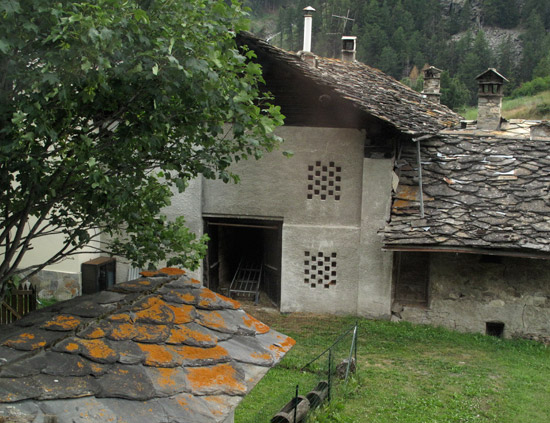
The mountains are steep at both north and south. Vineyards face southwest on steep slopes.
Castles sit atop high promontories. Lettering has changed to old gothic. I’m sure the language is different, too. The rivers are gray-green and opaque. (Language is the “secret, magic decoder ring” to other worlds.)
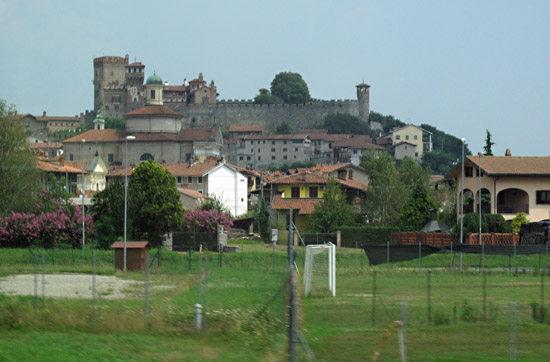

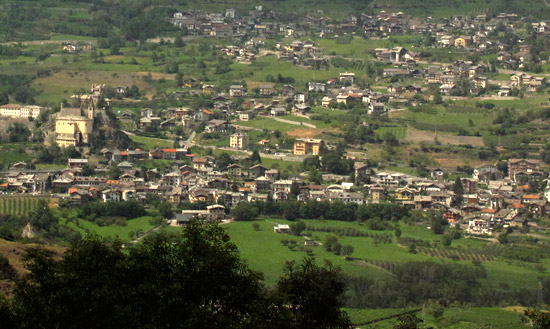
Aosta 3:15
Switch buses and then continue on to Cogne, (pronounced CONE-nyay) 50 minutes south, into the mountains. Signs are in Italian and/or French. Houses look like Americans’ stereotypical view of Swiss chalets, complete with decorations of gnomes and trolls. This is a different italy. Imagine how UNlike it is to Napoli and Sicilia!
This is a deep, narrow valley. Houses and farm fields climb the slopes to the north and south of town. An alpine community, certainly.
I think of their having united as one Republic less than 100 years ago (1946). About like binding New York City with Montana: separate worlds without commonality.
(“This way to beds in Europe.” Are Holiday Inns everywhere?)
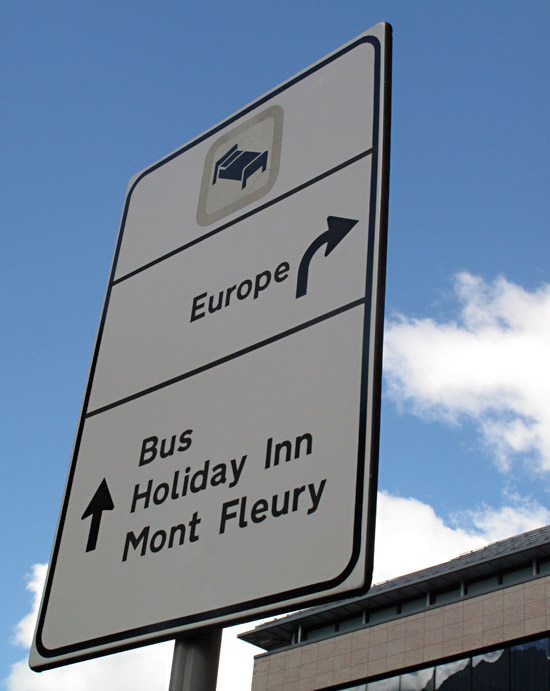
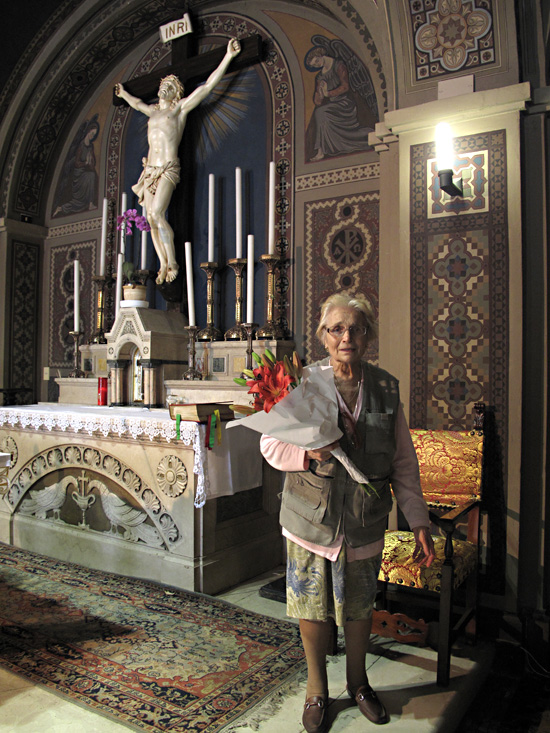
by Maureen | Jul 20, 2010 | Church, Featured Articles, Introspection, Journal, People, Photo of the Day, Photos
It would have been impossible to leave Milano without saying “goodbye” to Mary.
Our first meeting is a story in itself, finally happening last March after much anticipation. We’ve seen each other a few times since then, meeting in the little office behind the cemetery chapel.
Today I showed up in the afternoon, after the typical Italian lunch break, with red lilies in-hand for Mary. I found her at the altar, preparing everything for the next Mass. She lit up in surprise, and immediately went into the back room to split the lilies into 3 vases: 1 for either side of the altar, 1 for the Madonna.
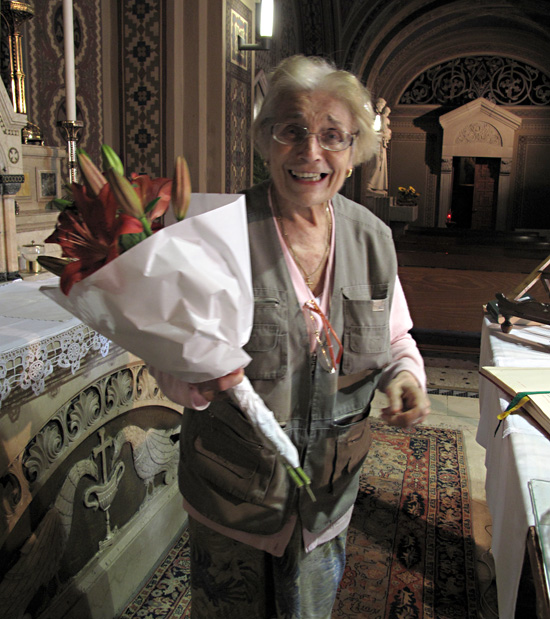
She’s the sweetest, and implored that I NOT move away from Milano. But as I’ve told her before, I have family, friends and work back in Seattle that pull me there, so I must go. Don’t think she didn’t try to convince me to stay though!

We sat at her desk and talked for a long time. We exchanged mailing addresses and I told her that, with the computer, I can call her for free. She was thrilled.
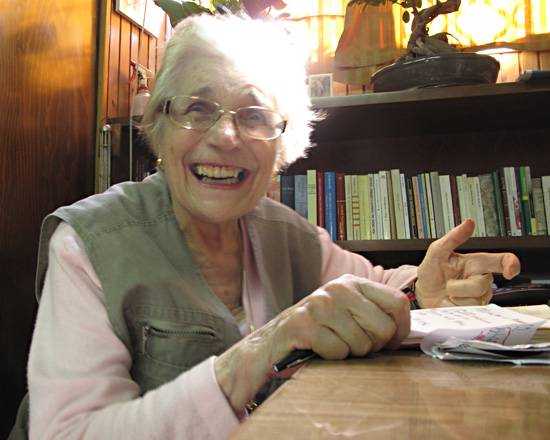
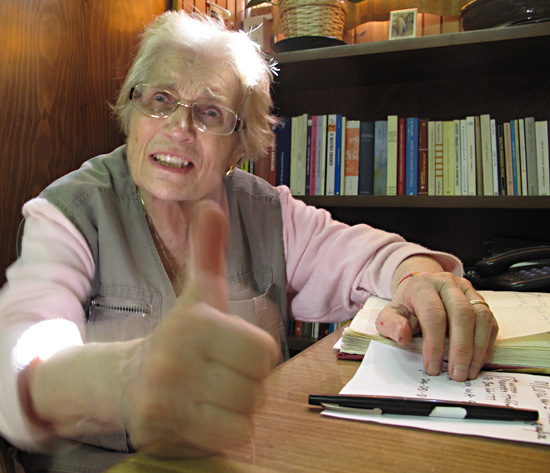
She rummaged through the cupboards, wanting to send me home with gifts. She found a bottle of Muscat sparkling wine produced by the friars, a bracelet with pictures of 12 saints, a rose-scented rosary, a little bottle of holy water and half a dozen copies of the photo of Don Giuseppe Gervasini, Milano’s very own protector. If I carry his image with me, he will protect me from all harms, she explained.
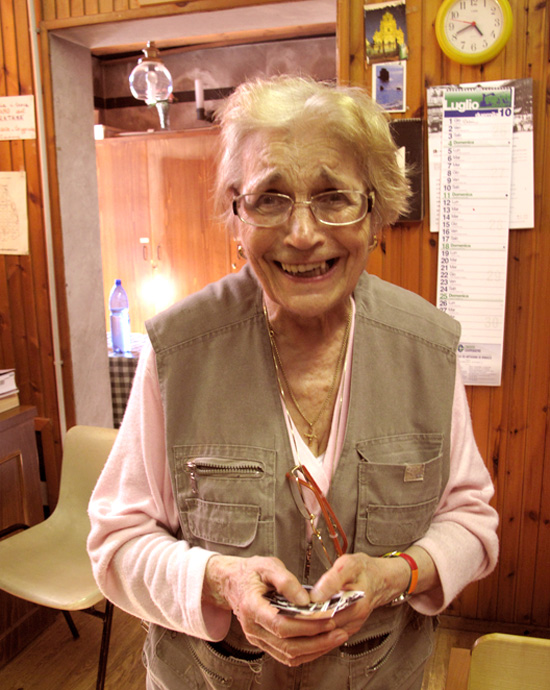
Mary also gave me a couple dozen pages on which she has written, in her “rotondo penmanship”, the names of the dead being honored at the chapel masses.
Father Francesco came into the office a few times. I had met him in my previous visits; during the last, Mary asked him to bless me for the answer to my prayers.
When we finally said our goodbye, I said “first, an Italian kiss, then an American hug”. We kissed on both cheeks, actually several times, then I gave her a big hug goodbye.
What a dear, dear lady. Meeting her has been one of the great treasures of my time here.
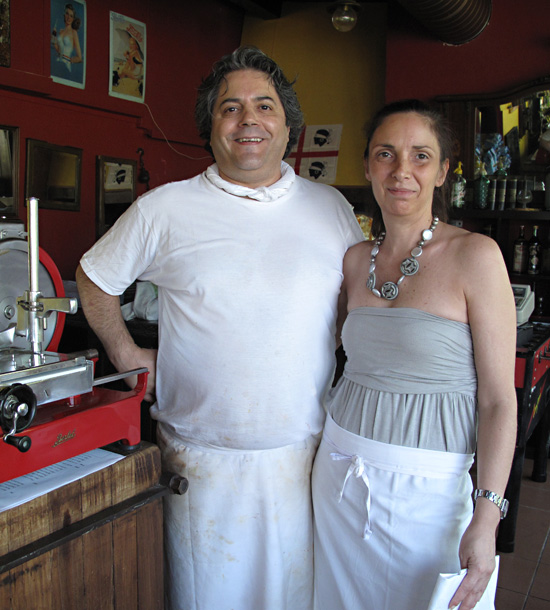
by Maureen | Jul 15, 2010 | Discoveries, Featured Articles, Food!, Journal, Meals, People, Photos
Octopus as tender as a dream, served warm and simply, with potatoes, olives and olive oil. Fish and pasta prepared and presented with an expert hand. Warm-hearted hosts, all family, welcome their guests into an easy, comfortable dining room in their restaurant alongside the Naviglio Pavese canal: Carlotta Café Bar & Restaurant. If you want to eat at all in Milano, EAT HERE.
During my year here, I have eaten at the Carlotta Café 5 times, and each time I have swooned and savored my meal. The fish could not be fresher. The light seasonings could not be more perfected. The preparation of every dish has never been pretentiously grand; it is simple, pure and complete. It’s no wonder I keep going back.
Carlotta Café owners, Ninni and Agnese, have had the restaurant for 13 years.

Siblings, Carlotta (after whom the restaurant is named) and Erik, work with their Mother in serving the café patrons. Erik is as attentive and welcoming as one could wish for when out for a nice meal.
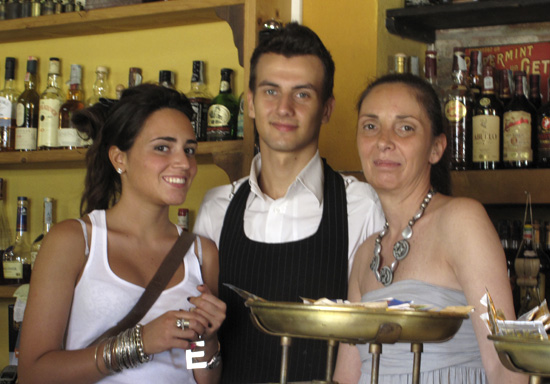
Here are a few of the dishes I’ve enjoyed in my times at the restaurant.
(The photos were taken in varying lighting conditions, evening and daytime.)
Pane Carasau, also called “Paper Music”, is a wispy-thin cracker served hot, generously drizzled with a flavorful olive oil and brightened with salt. This bread starts the meal and wakes up the mouth.
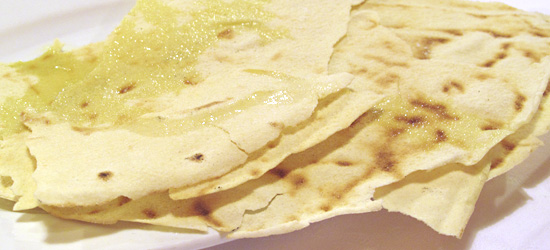
The dish that keeps bringing me back for more: Piovra con Patate – Octopus with Potatoes.
I can’t even descibe how delicious it is.
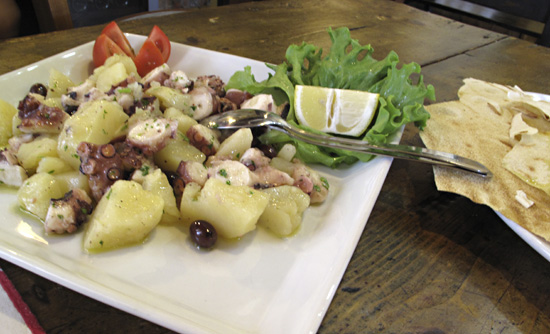
Gamberi Rossi Crudi della Mediterranea – Mediterranean Red Shrimp, served raw – are a delicacy and a gift to the palate.
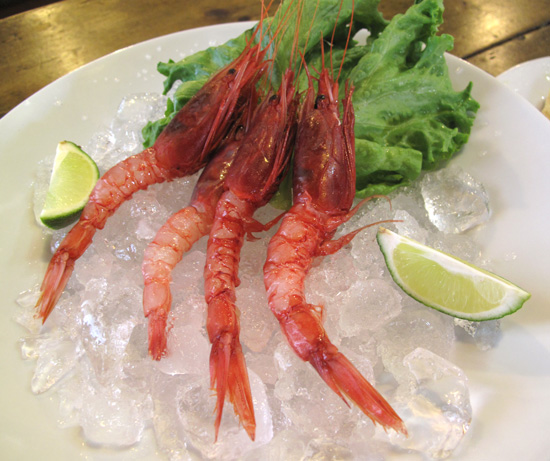
This shrimp will be splashed with lime and relished.
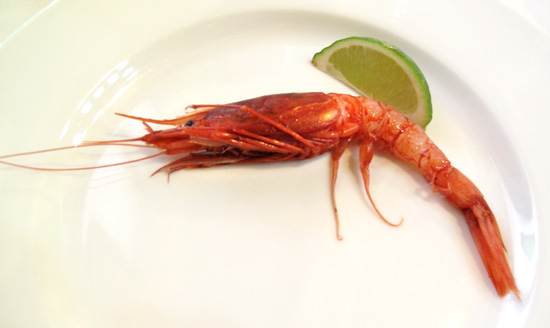
Spaghetti con Vongole e Bottarga – Spaghetti with clams and grated, dried fish roe.
Bottarga is a southern Italian gourmet specialty.
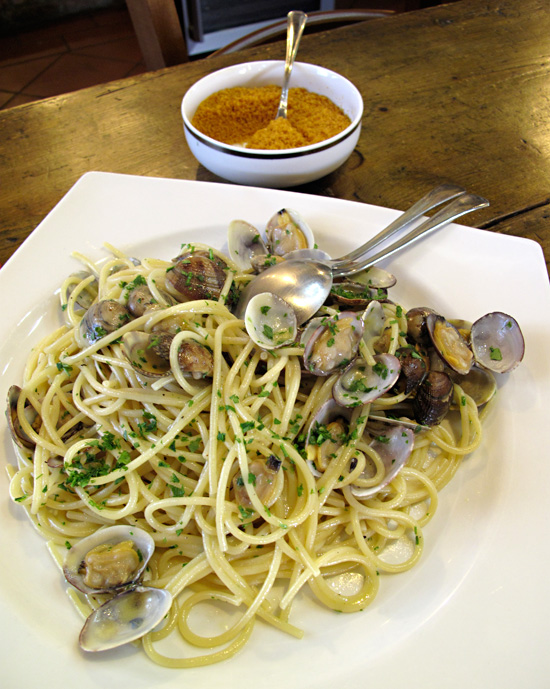
Branzino Vernaccia con Olive – Baked seabass with olives and olive oil.
Look at how beautiful those filets are. Ninni knows how to handle fish!
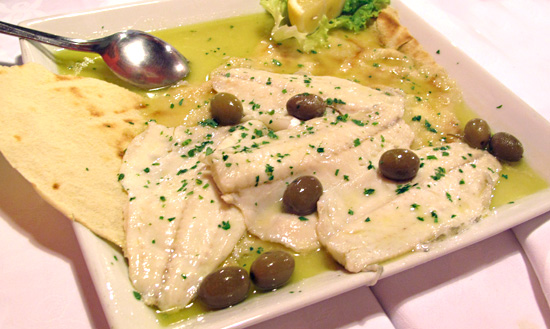
Carpaccio di Spada – Thinly sliced, raw swordfish, served with rucola – arugula – and tomato.
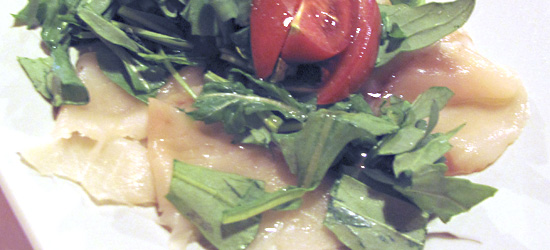
Paccheri all’Isolana – Paccheri pasta with tuna, basil and tomato.
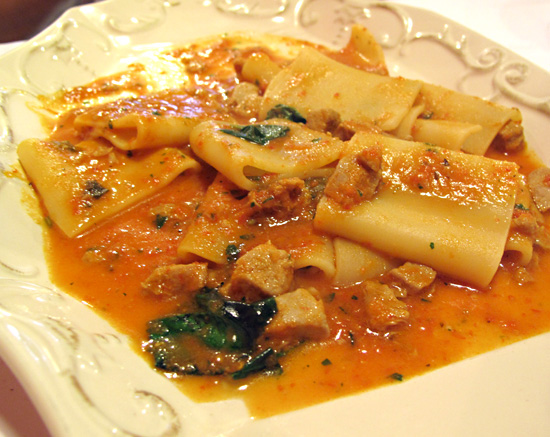
Gnocchi con Speck e Rucola – Potato Gnocchi with lightly smoked speck (cured meat somewhat similar to prosciutto), arugula and a creamy sauce.
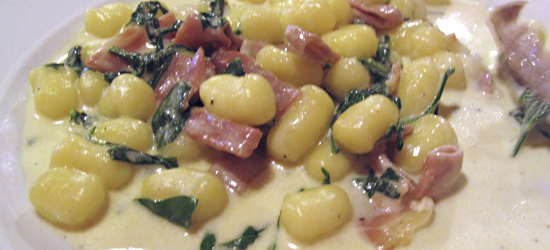
The Carlotta Café offers a full bar, wine list and caffé. Order an ice-cold bottle of Mirto, a Sardegnan specialty from myrtle leaves and berries, as a digestif to sip after your meal.
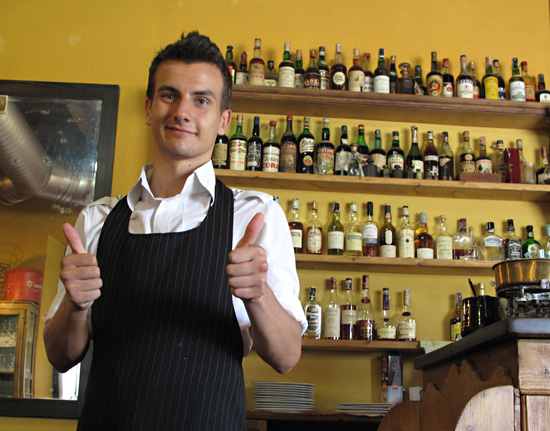
The Red Room is the quiet, more intimate room set off from the bar and main dining area.
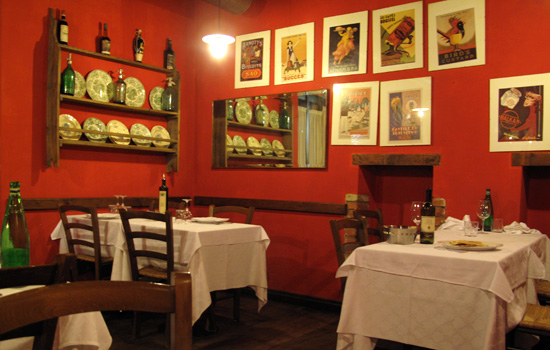
There’s also a north-facing Terrazo Room with it’s pleasant light.
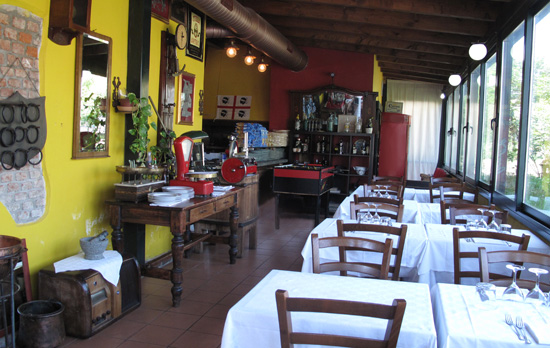
The café is not in the central hub-bub of town, and unlikely to be found by tourists. It’s not close to a subway stop and, for me without a car or scooter, it would be a long walk on a hot day. So I gladly take a quick cab ride to the restaurant and it is oh-so worth it.
Ninni and Agnese offer a “Cena a Base di Pesce“, dinner based on fish, at an incredibly reasonable price. Make it simple for yourself: order this special dinner and a nice bottle of wine then sit back and enjoy the steady stream of expertly prepared foods that arrive at your table. You will go home happily satisfied. And you, too, will dream about the octopus. (Tell them “Maureen” sent you.)
(Check with them on their current pricing, since it may change.)
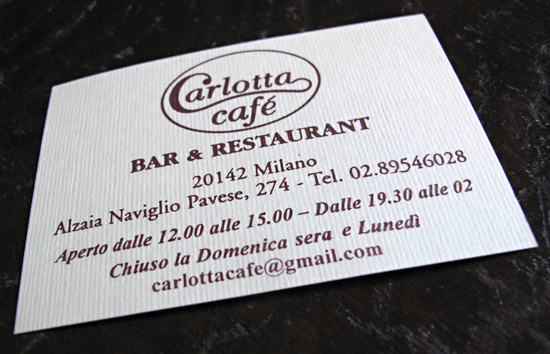
Carlotta Café Bar & Restaurant
Alzaia Naviglio Pavese, 274
20142 Milano, Italia
TEL: 02.89546028
E-MAIL: carlottacafe@gmail.com
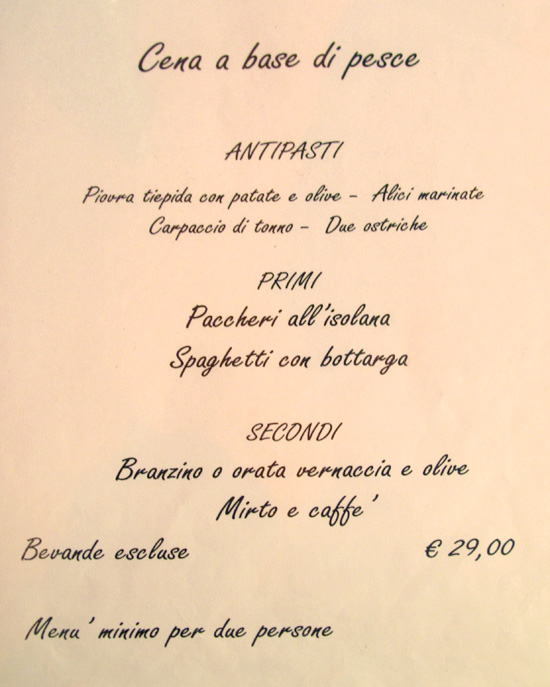
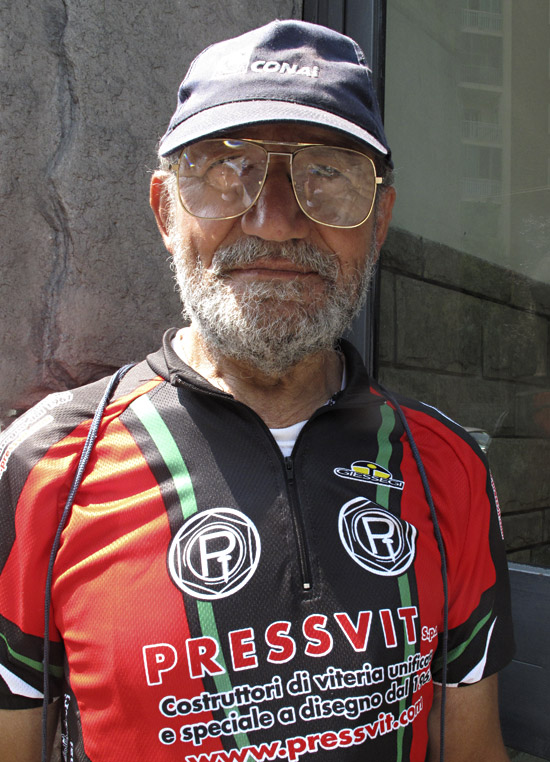
by Maureen | Jul 14, 2010 | Featured Articles, Journal, People, Photo of the Day, Photos
My “History Buff on Wheels“, Angelo, went rolling past me along the canal this morning. In a cycling daze and not recognizing him, I nodded and said the usual “ciao” as one cyclist to another. Mere moments later, he pulled up on my left, took my pace, greeted me and commented that it had been a long time since we had seen each other.
“Angelo! Ciao!”
What a great surprise to see him.
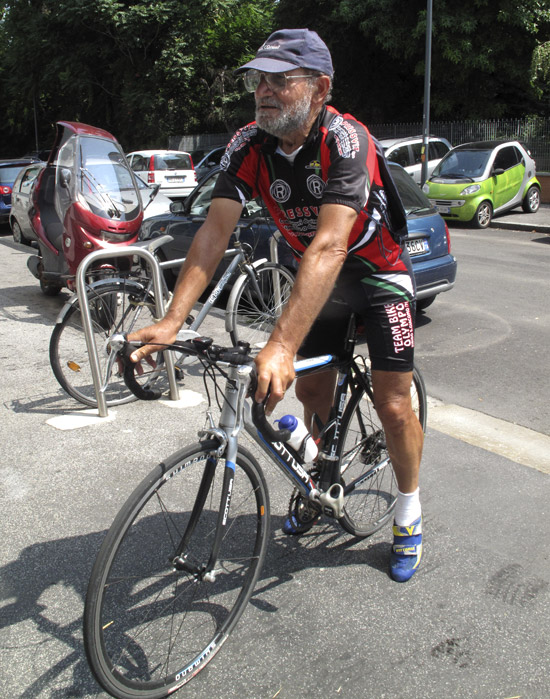
It had been January 11th, a very cold day, when we had ended up riding for 3 hours together, and all that time he had given me an historic commentary on Italy, Europe, the wars and politicians. It was Angelo that showed me the little back roads through the farmland that I have come to cherish so much. It was Angelo that first took me to Cascina Femegro, where I now go for the fresh ricotta cheese I savor.
Today, we rode for a half an hour together, all the way back to my place. We stood out on the walk under the scorching sun, talking about more history and geography, language and dialects. What a pleasure. We said a warm goodbye, but hoped to see each other another day on the bike path before I go.
“Ciao, Angelo!”

by Maureen | Jul 11, 2010 | Introspection, Journal, Quips
This is not a scholarly blog with a foundation in formal Art or European History. I’m the first to admit my ignorance in those realms. And on the web, one can find formal information and imagery on just about any topic. I have no desire to regurgitate what’s readily available out there, although I do provide links now and then to informative sites.
Rather, this is a collection of sometimes-knee-jerk, sometimes-thoughtful observations and responses to having plopped myself down in Milano for a year. I write about the jaw-droppingly beautiful, the quirky and questionable, the forefront, the frustrating and the fulfilling.
Living here is “the stuff of dreams”, but it is not “glamorous” as so many seem to believe. It is daily life in a place where they speak a different language and do things differently, all against a backdrop that sometimes takes my breath away from either beauty or cigarette smoke.
I write about ants in my kitchen and hardwater in my pipes. About an old lady in her pajamas on New Year’s Day, and an old man gathering fire wood along the canal. There’ve been stories about feeding fresh ricotta cheese to farm cats, buying old linens at the flea market, and eating pureéd rabbit livers and raw meat.
This blog is simply about what catches my eye, my mind and my heart. It is increasingly populated with stories of the people that have stepped into my days. I’ve filled my mind with enough imagery to inspire me for a lifetime.
This is no movie set. The Lombardia sun is usually obscured by haze. The winter was interminably gray. There is “dog do” on the sidewalks and no one else to handle the details for me. But the struggles have been authentic. The food is remarkably unlike an Italian restaurant menu in the U.S. The people have been slowly responsive. And I’ve started to “talk with my hands”, especially when in an animated conversation in Italian with a friend.
Having been here now for over a year, and facing an imminent departure and return to The States, I feel mixed and wistful… and deeply full.
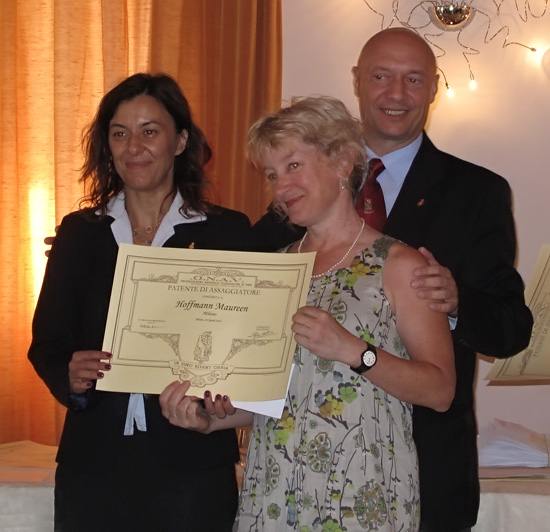
by Maureen | Jul 7, 2010 | Featured Articles, Food!, Franciacorta, Incredible Locations, Journal, Meals, People, Photos
The grape varieties and resulting wines here in Italy are numerous and quite different than in the U.S. What better way, then, to learn about the wine I’m drinking than to take a wine-tasting class. After attending intensive language classes last winter, I figured I was ready to enroll in the preliminary class series offered by the Organizzazione Nazionale Assaggiatori di Vino (ONAV) – the National Organization of Wine Tasters.
Some of my Seattle friends have joked that the class was a bunch of people sitting around drinking wine. “Hey! How do you like this wine?” “It’s great. Pass me the bottle!”
No. It was a series of 18 lessons, 2 per week, from 9:00 in the evening ’til 11:00 or so. It was held across town and I usually got home on the subway after midnight. (I started the class in February.) The course content was very technical, including discussions of chemistry, cultivation and fermentation processes, wine types and their characteristics, defects and regulations.
And all of this was in Italian. Each session was taught by a person with a different expertise… and a different manner of speaking. On good nights I understood 80% of what was said. (At least I think so.) There were a few nights when I may have understood only 10 -20%. Most lessons were complete with powerpoint presentations, charts and graphs. What I couldn’t understand by listening I could understand by reading. I felt I was learning more than I knew before, even though I didn’t get it all.
Most evenings, we had 4 wines to taste, being given a small sampling of each but not even taking the first sip until about 10:30. We used a complex table to judge each wine for its visual, olfactory and in-the-mouth characteristics, tallying a score for each wine on a 100-point scale. We judged on clarity, tone, intensity, frankness, fineness, harmony, body, persistence and overall ranking.
Taking the class did change my understanding of and appreciation for wine. And it probably spoiled me for drinking “cheap wine”, though here in Italy I can get a pretty nice, very drinkable wine for 4 or 5 euro. ($5 or $6)
When the class was ending in late April, we were told to prepare for the final exam. Yes. A final exam! I considered not taking the test; after all, I had attended the course simply for my own interest, not to become an official sommelier.
Having convinced myself to take the exam, I then considered taking the test in English, an option offered. But no. I took the 10-question short essay test in Italian. I had to understand the question; know the answer and know how to say and write it in Italian! We then had 5 wines to taste and judge; our judgments of the wine were expected to fall within a few points of the ONAV judgments. (ONAV was serious! They had several versions of the test. We had to sit with an empty chair between us. And we had to remain silent.)
I passed! It was a little, personal triumph.
Last Sunday we had our diploma ceremony at the beautiful Ferghettina vineyard high on a hill in the Franciacorta region east of Milan. Our class was joined by classes from other locations of the Lombardia region of Italy for one grand celebration.
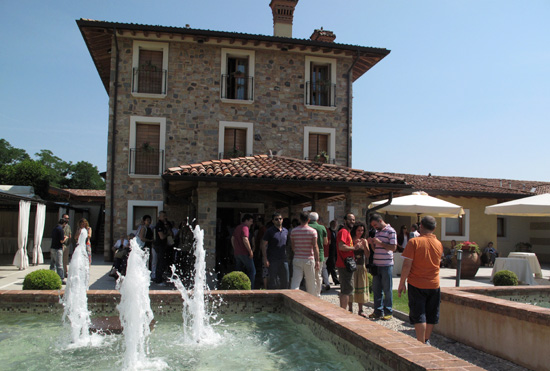
Not having a car, I could not have attended without the kindness of my classmate, Giuseppe, letting me ride along with him and Alessandro. Once there, we met up with Federica and Valentina from our class.
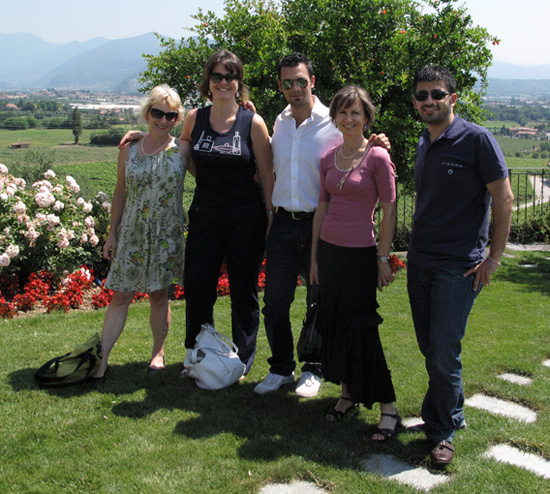
Rocco and Gianni were also there, as were other classmates.
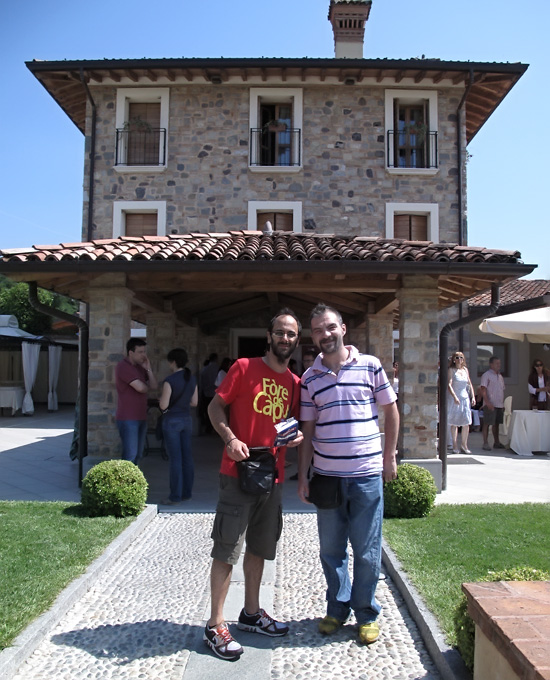
Our names were called out individually and we went to the front to receive our diplomas.

Afterwards, we were treated to Ferghettina Brut, along with typical meats, cheeses and breads. On that sweltering hot day, a tour of the winery’s cool, underground “cantina” was a refreshing break, and fascinating.
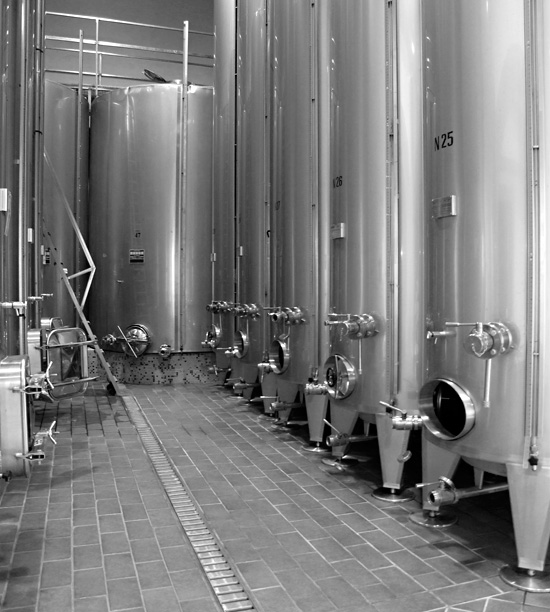
.
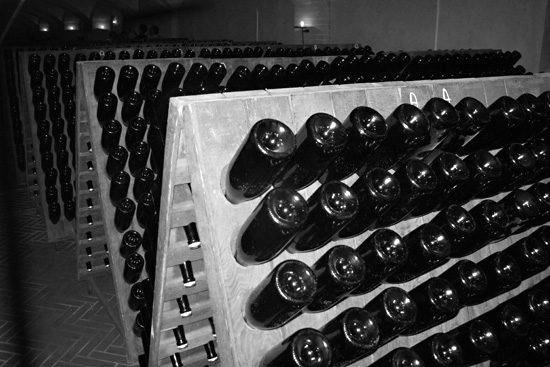
.
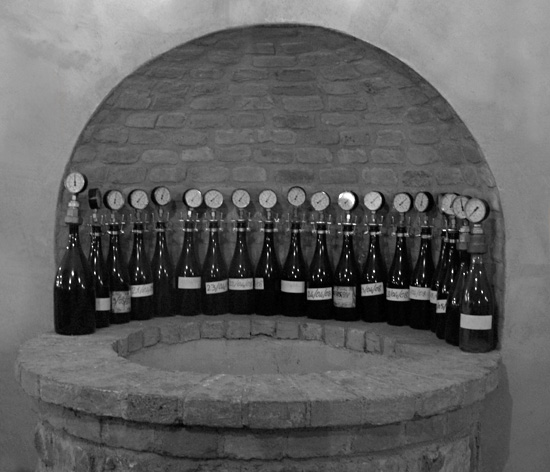
.
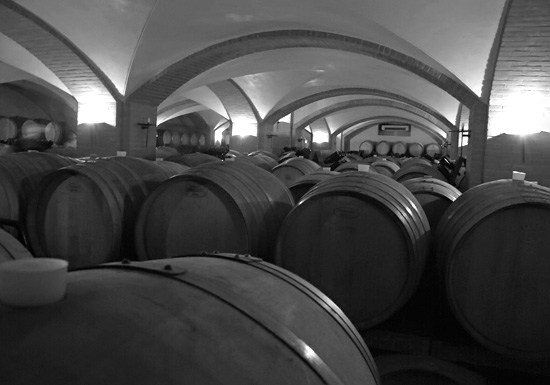
Ahh, nice and cool standing next to the 2008 Franciacorta Brut.
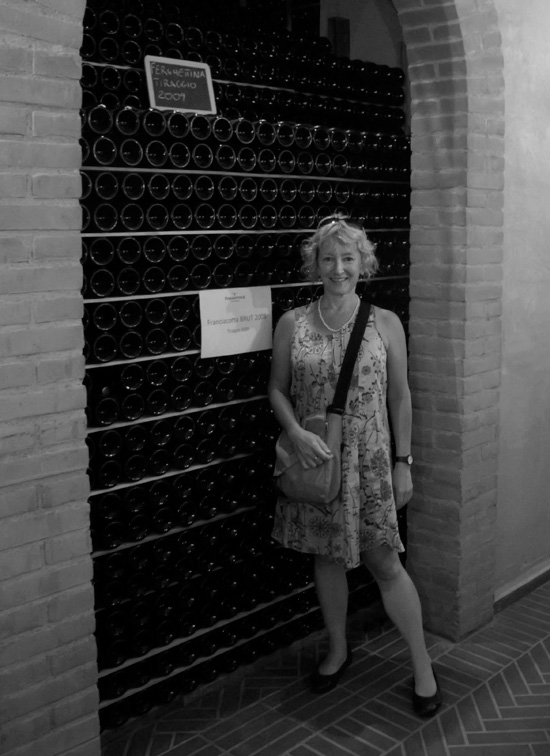
After celebrating with our other ONAV classmates, the 5 of us headed off in two cars to a place that Federica had heard about. It was a laughable, roundabout tour through the countryside of Brescia trying to find the agriturismo, Cá del Lupo. We enjoyed a light lunch on the terrace: Alessandro, Valentina, Giuseppe and Federica.
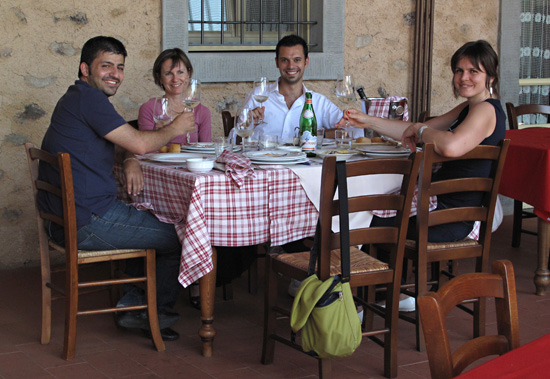
Alessandro.
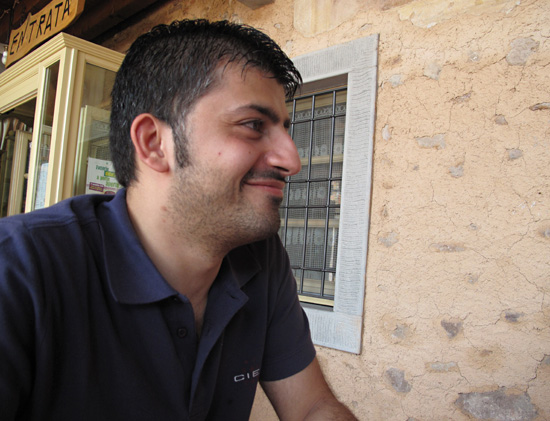
Valentina.
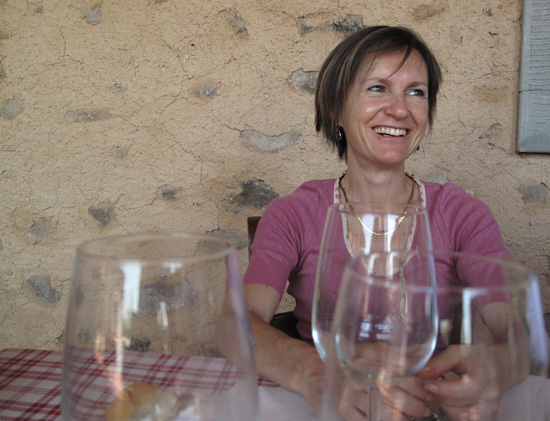
Giuseppe.
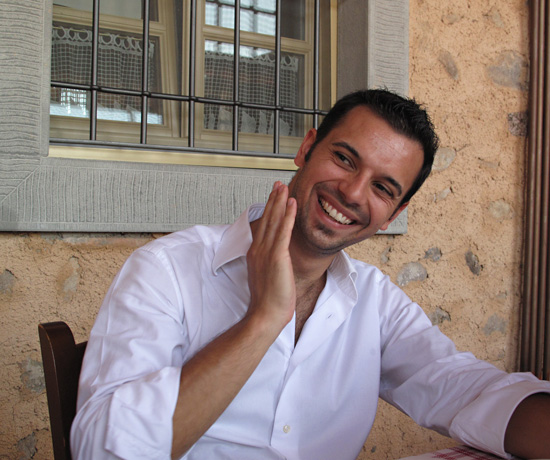
Federica.
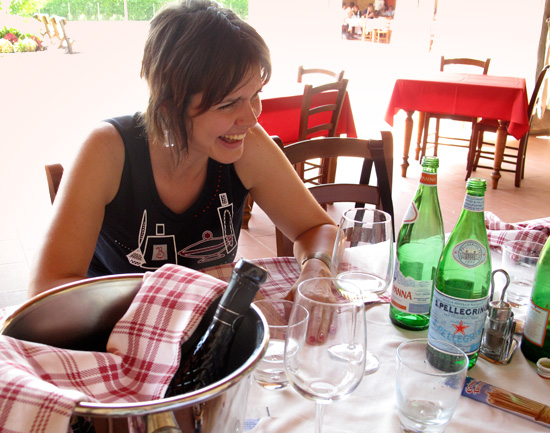
It took much hemming-and-hawing to decide whether to go walk along the shore of Lago d’Iseo. We consulted the GPS to figure out how to get there and how long it would take.
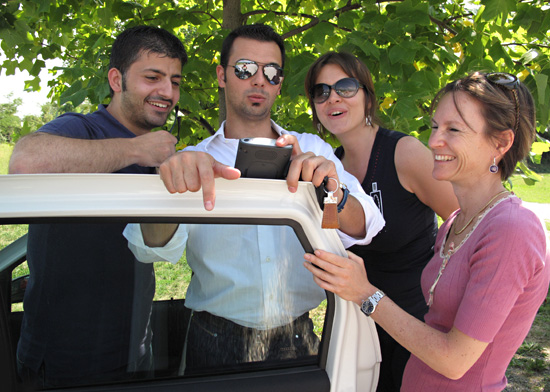
Lago d’Iseo is between Lago di Como and Lago di Garda, nestled in the ring of mountains to the north.
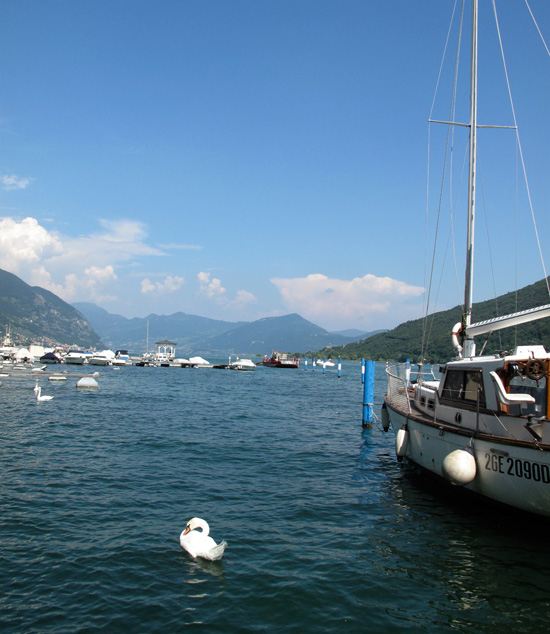
Alessandro and I goofed off at the cartoon characters on the lawn.
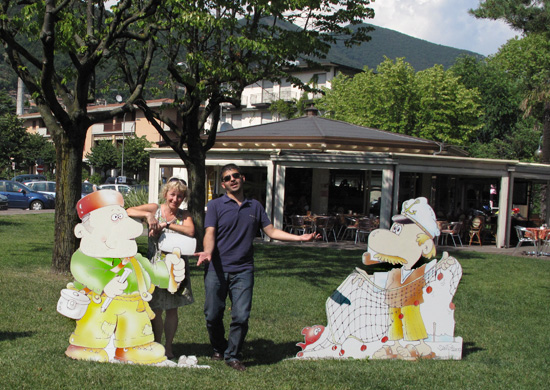
I spent my very hot Fourth of July at a winery, a farm and a lake, with 4 dear people I hardly knew. We had a wonderful time and laughed a lot. One of more of them may end up on my doorstep in Seattle some day!

by Maureen | Jul 6, 2010 | Discoveries, Featured Articles, Food!, Incredible Locations, Journal, Meals, People, Photo of the Day, Photos, Sanremo
Last Friday, after my whirlwind morning in Genova, I continued on to Sanremo for what was likely my last visit with my “landlady” Sandra and her husband, Mauro, before my departure from Milano. I had visited them a couple of times in winter and at my departure then it felt as if longtime friends were bidding “arrivederci“.
It was hot even in Sanremo, which is usually milder than the inland. Sandra and I sat in the cool of the house, and later on the porch swing, covering every topic from food and family, to health, spirituality, friendship and life approach. (Not bad considering it was all in Italian.)
Mid-afternoon, it was time to start dinner: homemade Sardenara and Focaccia, carpaccio of Tuna (thin slices of raw tuna), and insalata di gamberi e rucola (salad of shrimp and arugula).
Sardenara is specific to Liguria, the part of Italy up north and west along the Riviera, approaching France. You can’t quite call Sardenara “pizza”, but rather a focaccia pan bread with very specific ingredients. Sandra made a dough of a specific semolina flour purchased especially for this recipe. A friend, Angelo, had shown her how to make this.
She rolled and formed the dough into the square baking pans, then set them aside to rise.
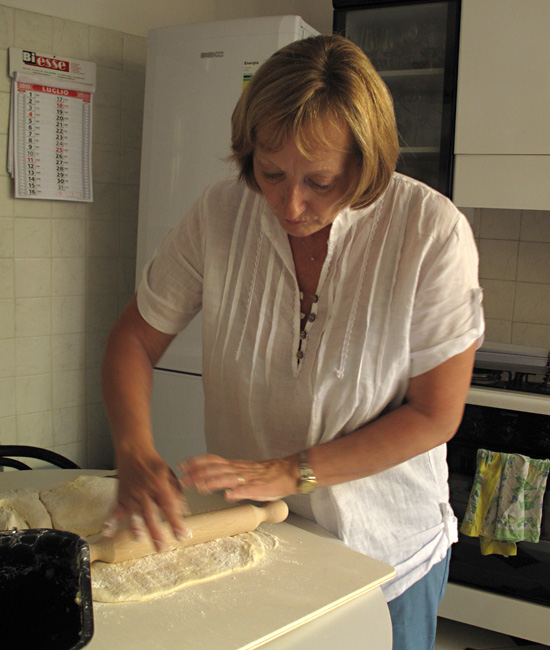
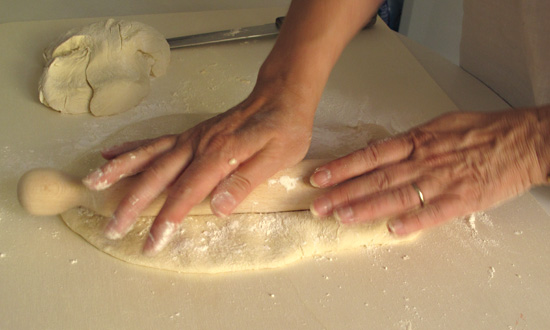
After the dough had risen, Sandra selected one pan for a simple focaccia with coarse salt and olive oil. The finger indentations in the dough, and more than a splash of water (!) poured on top before going into the oven, were two secrets important to the recipe.
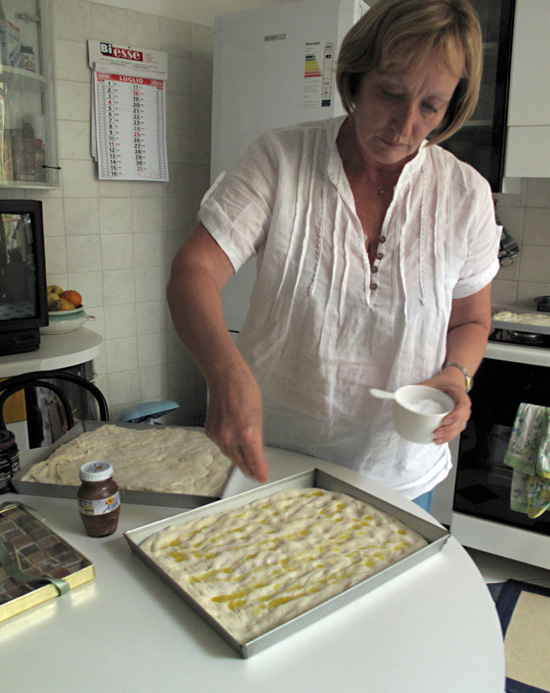
Next came the very simple, yet specific, Sardenara preparation: a base of peeled, cooked tomatoes; taggiasche olives, local to the region; salted anchovies; garlic cloves, olive oil, oregano, coarse salt, water.
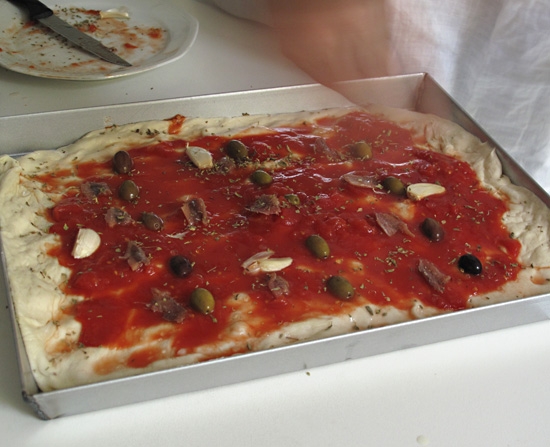
The Sardenara cooked up to a half-inch thick bread with a wisp of tomato and the pungency of olive and anchovy. It began our dinner.
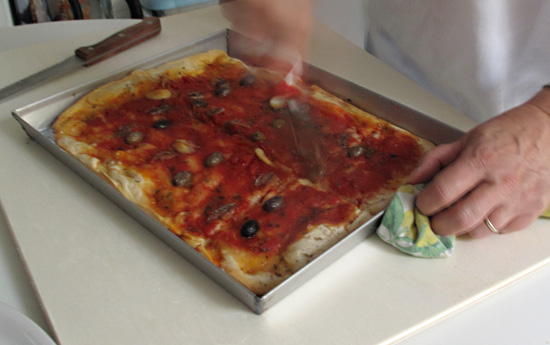
Mauro, Sandra’s husband, was hungry and ready for dinner.
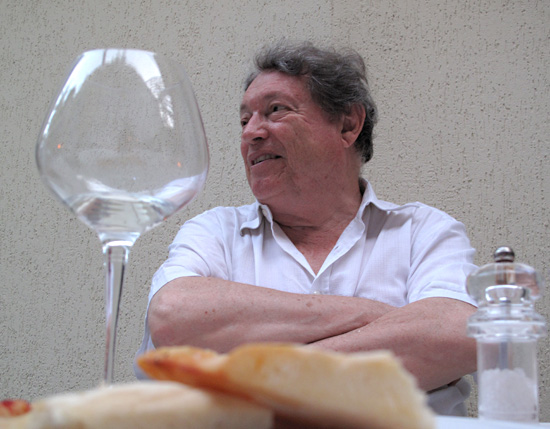
A perfect summer meal, begun with fresh Sardenara, and followed with a simple salad of arugula and shrimp, and tuna carpaccio. All light and delicious for a hot day.
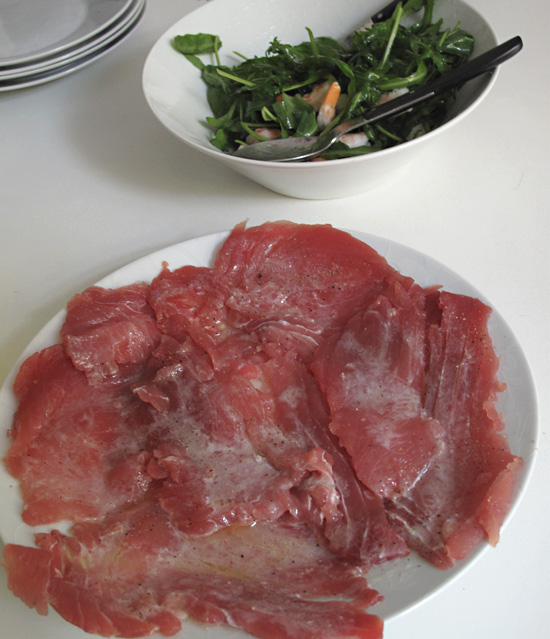
Sandra and Mauro’s friend, Sandro, joined us for the meal. We had all spent time together in the wintertime, (including our trip to Monaco and a meal of Sandro’s special pureéd rabbit liver sauce over freshly-made pasta). He dished up the tuna carpaccio, which had been doused with fresh-squeezed lemon juice and olive oil. It was fantastic!
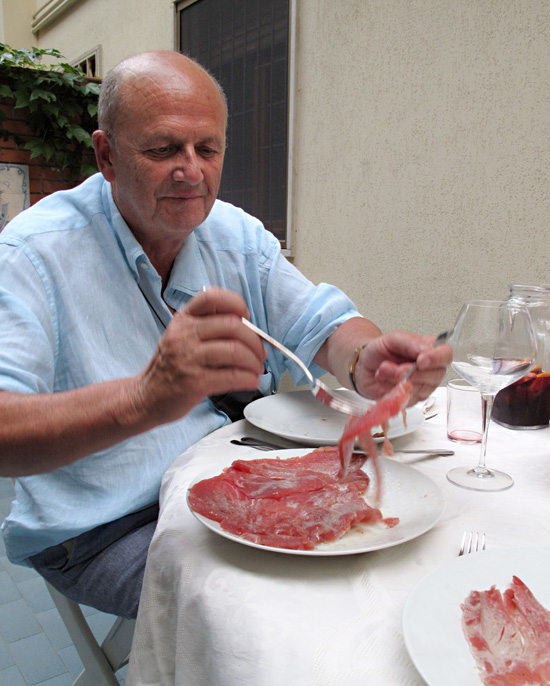
The salad was dressed simply with lemon juice, olive oil, salt and pepper.
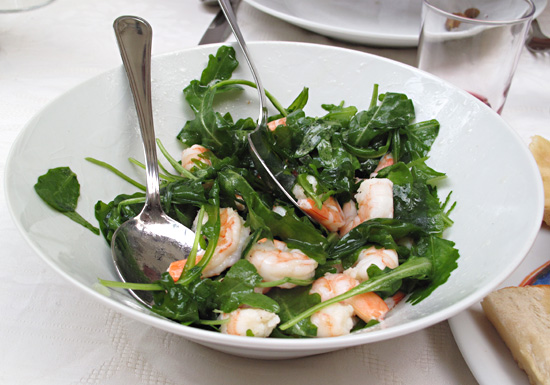
Dinner was a lovely time with my new “old friends”. And the making of it was as much a part of the pleasure, as was the conversation throughout it all.
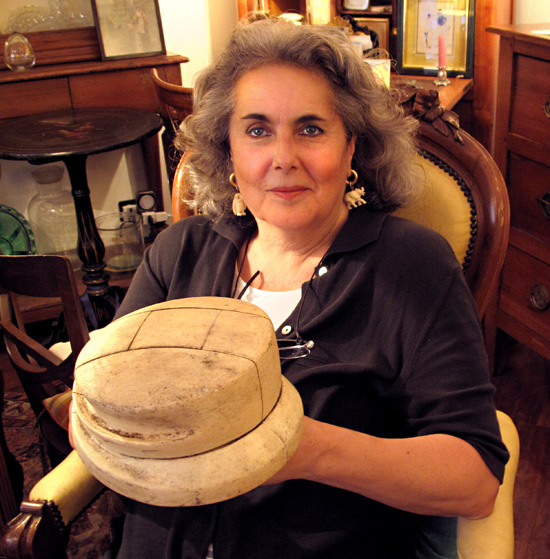
by Maureen | Jul 6, 2010 | Featured Articles, Genova, Incredible Locations, Journal, People, Photo of the Day, Photos
It all started with hat forms on Milan’s Grand Canal.

Five weeks ago I went to the Mercatone Antiquariato – Antique Market – along the Naviglio Grande and saw hat bases made of coarse fabric. They are from the Bovone sisters that were making hats in the 1930s. The hats have asymetrical, sumptuous curves and show the “hand” of their makers through stitches and markings.

The hat bases harkened to the beautifully-sculpted wooden hat forms I did NOT buy in Florence in March but still thought about. I bought 3, chatted a bit with the woman selling them and asked for her business card.
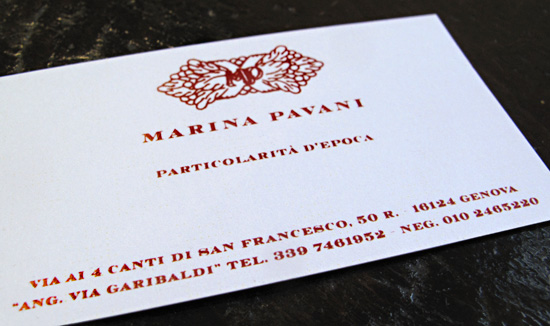
A week ago, back at the antique market, the woman was there again and she had wooden forms this time! I considered them all and picked one to bring home. The seller, Marina Pavina, and I introduced ourselves and talked some more. She was insistent: “you should come to Genova!” I had already planned to go through Genova, her home town, on my way to San Remo a week later, so we agreed to meet there.
At the end of the train ride from Milano, I stepped out of the station into a 90-degree day and was met by Marina and her husband, Claudio. They took me on a city overview driving tour of Genova, port city and home of Cristoforo Colombo. There was much that reminded me of Seattle: the waterside location, the surrounding ring of hills, the elevated viaduct, the busy international port. Yet it is all tighter and closer in.
Claudio stopped long enough for Marina and me to get out and see the front of Cristorforo’s house, as well as the adjacent towered city entry.
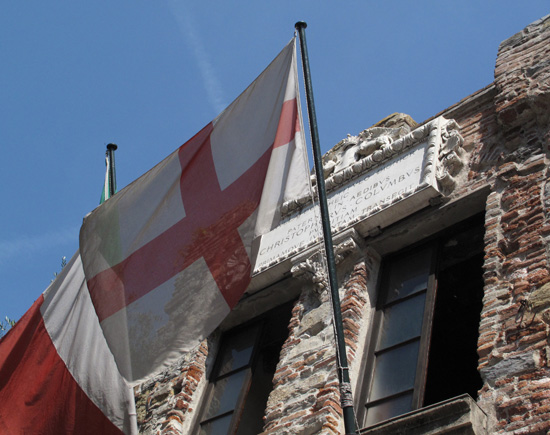
Two towers create an arched entry gate into Genova’s Molo neighborhood.
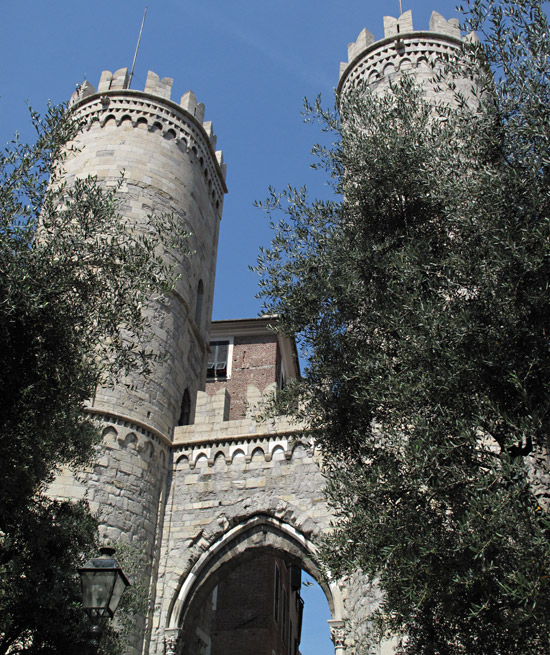
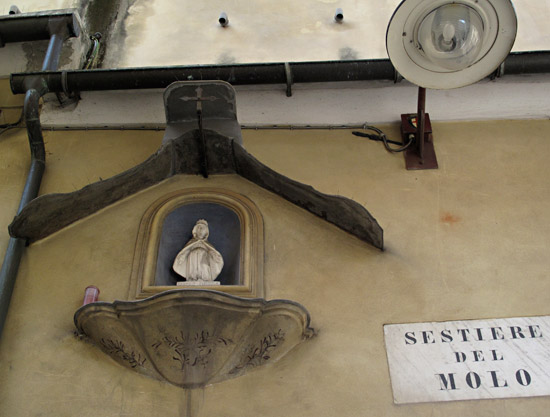
This madonna and two plaques are mounted underneath the arch. The top plaque is from 1865. (I’ve recently brushed up on reading roman numerals. It comes in handy here in Italy.) Madonnas and other religious niches like this are found all over Italy, reflecting the high number of Catholics in the country.
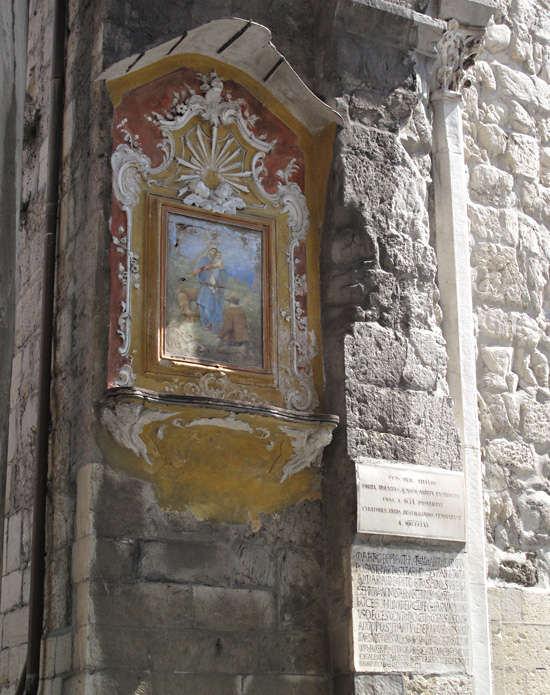
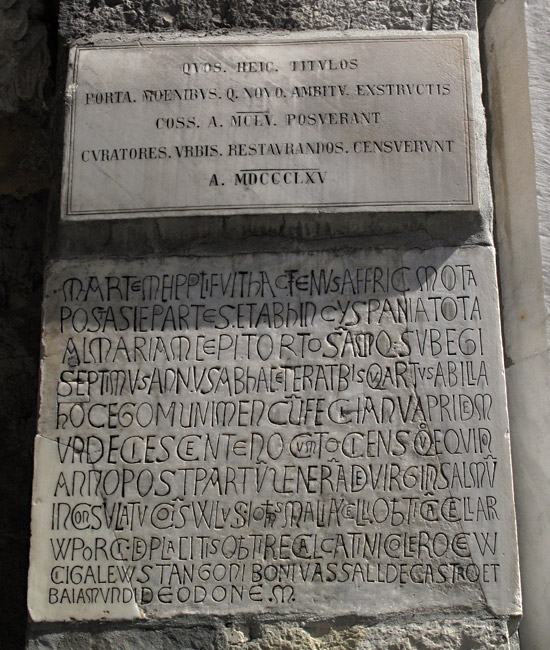
I’ve never seen such a concentration of scooters than in Genova, although I was told later that San Remo has more scooters per capita. In some places in the city, there are so many scooters parked along both sides of the street that there is just enough space for one car to pass between them, lane lines having no meaning.
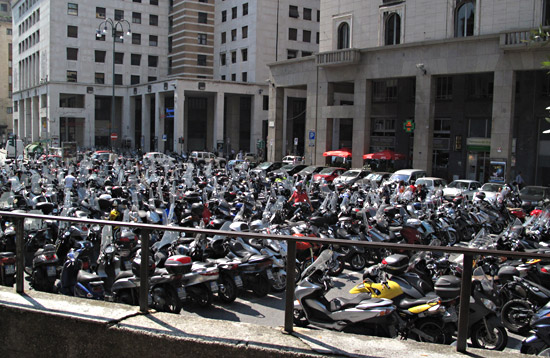
After our driving tour, we parked the car and took a stroll along the beautiful and historic Via Garibaldi. Genova has elaborately frescoed and decorated buildings like I’ve never seen (nor will) in Seattle. Just envision this building without its fresco painting!
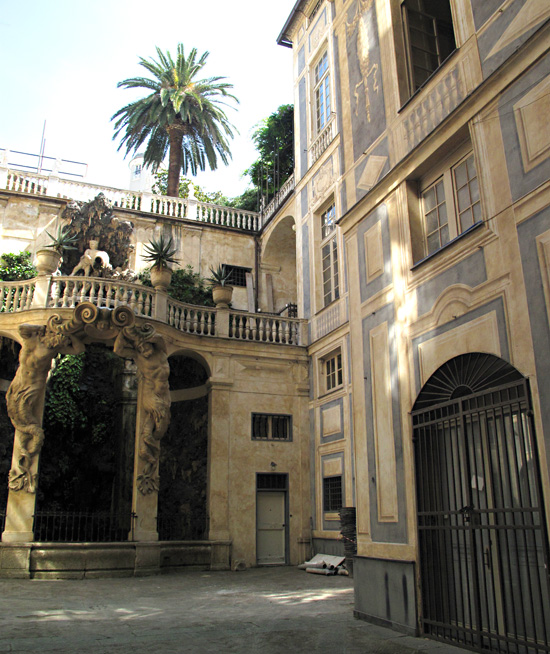
This is an interior foyer just off the street.
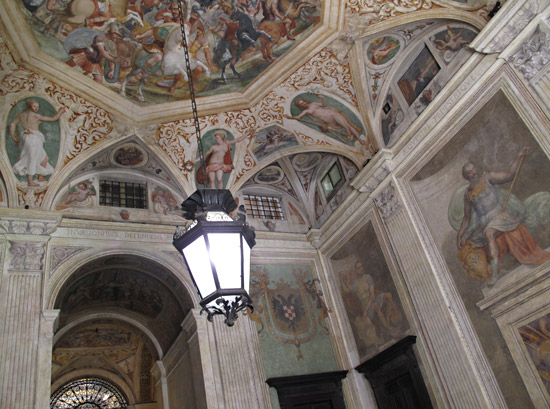
This ceiling reminds me of Wedgwood pottery.
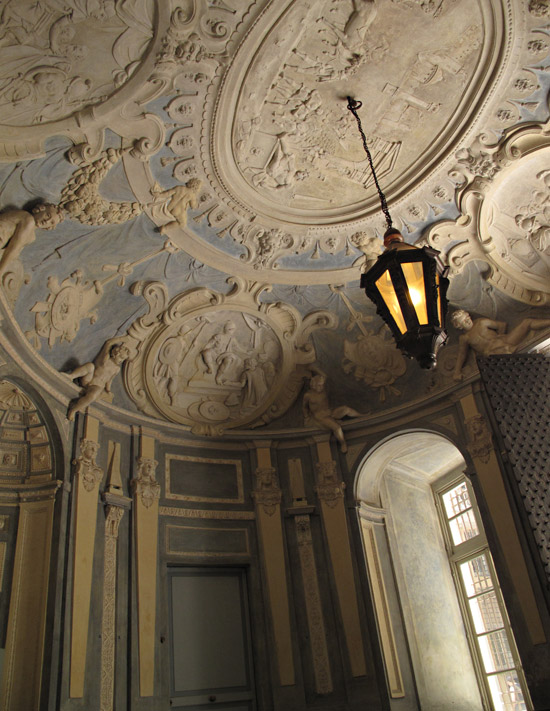
Our next stop was Marina’s antique shop, “Marina Pavani Particolaritá D’Epoca”, just off Via Garibaldi near the museums.
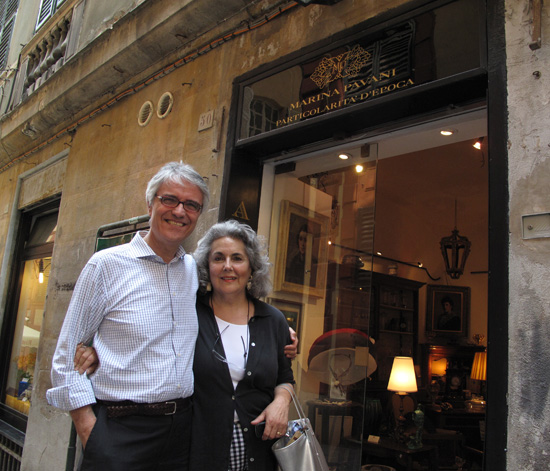
Marina offers art pieces, furnishings and decorative objets d’art covering a broad time period. Whether a person is looking for a large, prominent piece, or a small, visual detail, Marina’s collection piques the curiosity. She also does custom searches and display work.
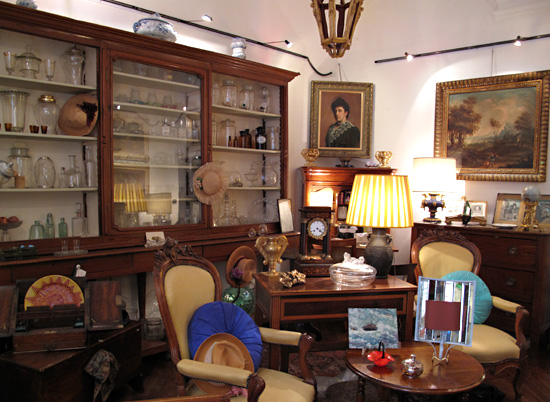
.
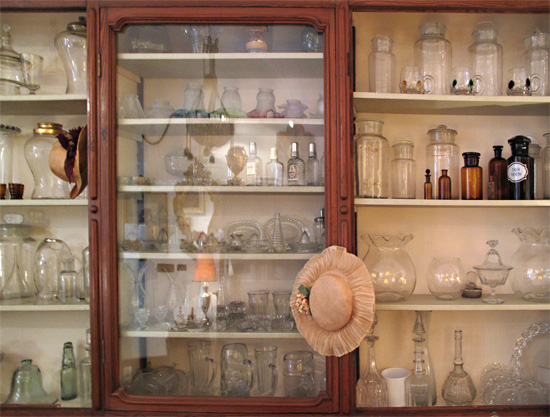
.
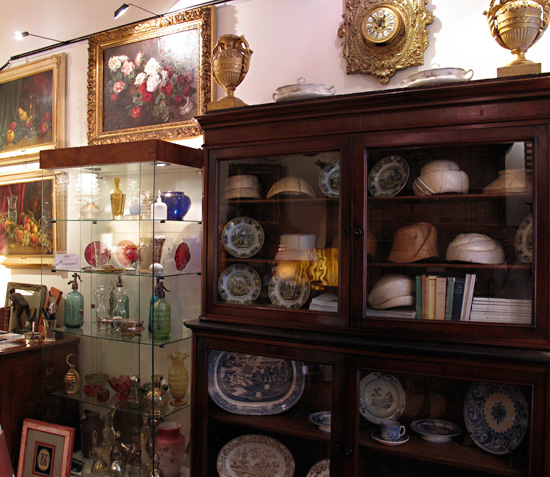
Here’s a sampling of some of the hat forms that caught my eye in the first place.
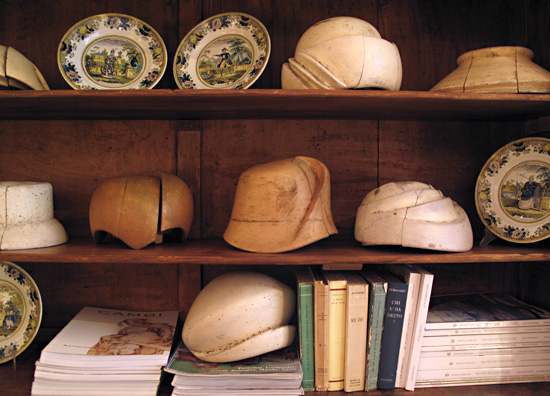
The hat forms are constructed of 5 wooden pieces joined with large dovetail joints, then sculpted and painted. Damp hat fabric, likely felt, is draped over the form, pressed and pinned into the depressions and left to dry. When removed, the fabric will have taken the shape of the hat form.
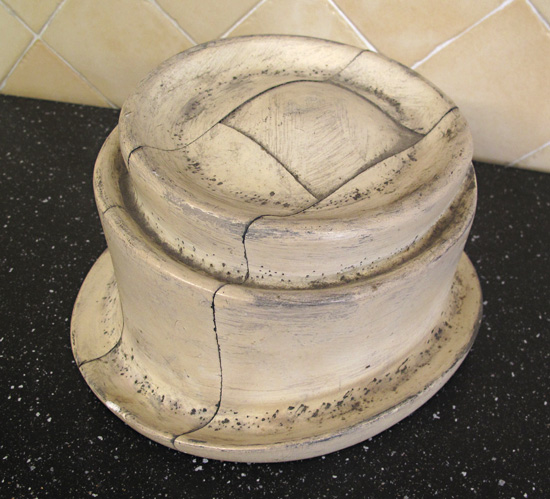
I bought this second one while in Marina’s shop in Genova. I like all the patina and pin holes as much as the lovely curves of the forms themselves.
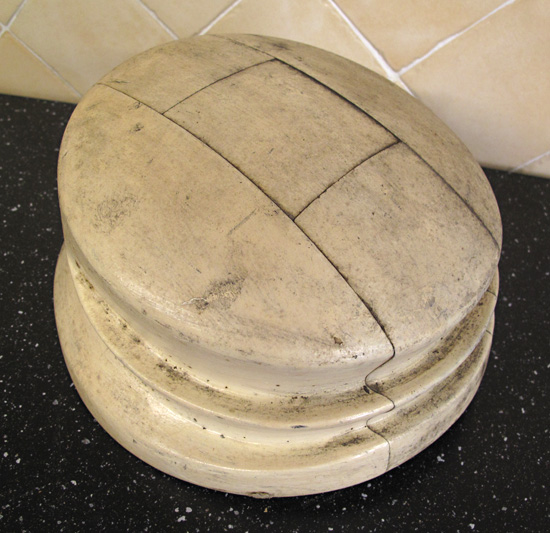
While looking at the underside, the dovetail joints and form numbers are visible.
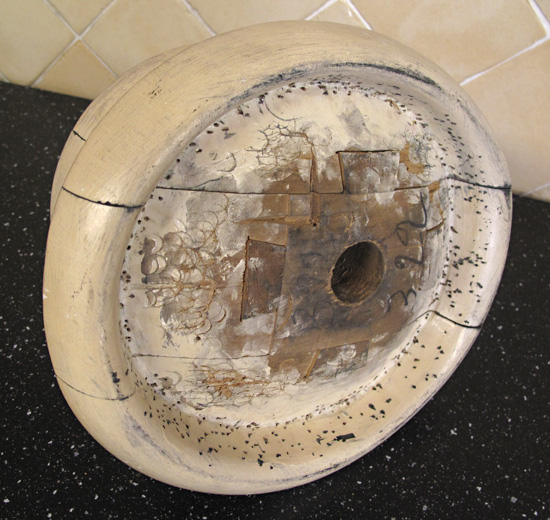
After browsing the antique shop, Marina and Claudio treated me to lunch at a cafe nearby.
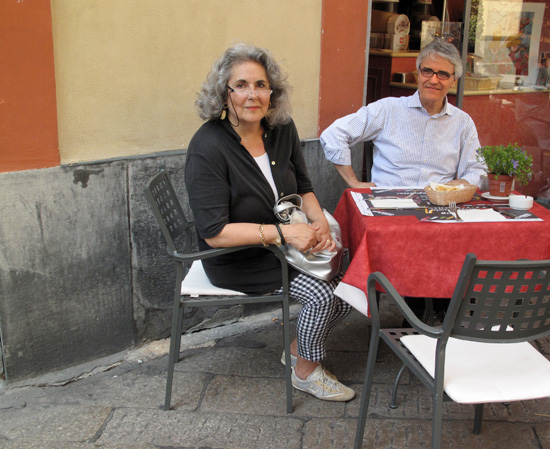
.
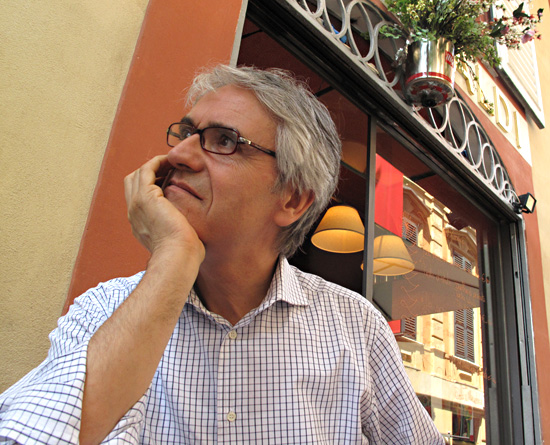
We rushed through our lunch and finished just in time for them to drop me off at the station and give each other quick goodbyes. I then waited on the platform for a half-hour-late train on a sweating-hot day.
What’s most remarkable to me, again, is the kindness of strangers that I have been encountering. I don’t know Marina and Claudio, and yet they hosted me warmly in their home town, and we chatted like long-time friends.
If you find yourself in Genova, step into Marina’s shop. See what catches your eye and enjoy a pleasant conversation.
Marina Pavani Particolaritá D’Epoca
Via Ai 4 Canti di San Francesco, 50 R. 16124 Genova, Italia
(Angolo Via Garibaldi)
Tel: 339-7461952
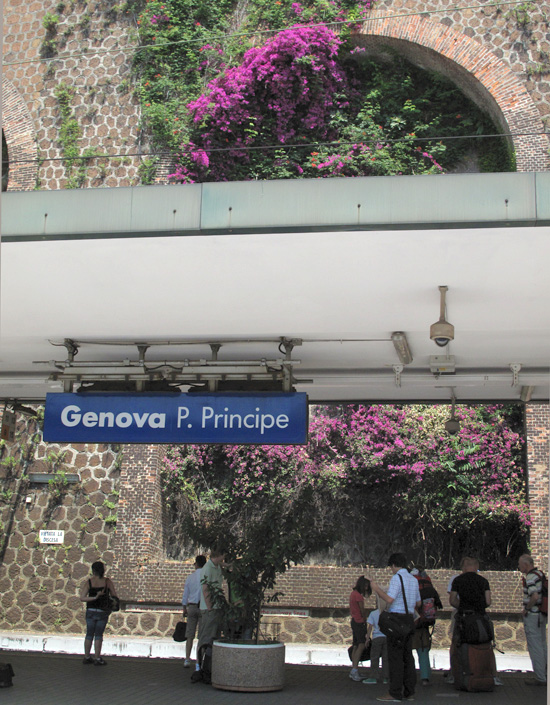
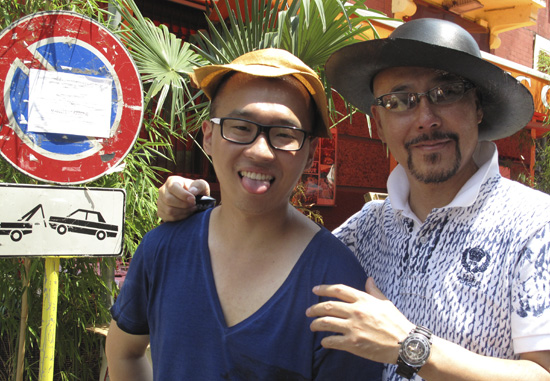
by Maureen | Jun 30, 2010 | Discoveries, Featured Articles, Food!, Journal, Meals, People, Photos
Two Chinese and one American strolling together along the Naviglio Grande speaking Italian, their only common language. Now if that doesn’t make you smile, I don’t know what will.
I had gone back to the Mercatone Antiquariato – The Big Antique Market – (the last one before my departure) in search of the few, last treasures. Three things called my name and came home with me and they will be some of the many things that bring Italy to mind when I’m back in the Pacific Northwest. I bought an old book, a wooden hat form, and a medallion… and then I was hungry.
The Naviglio Grande is lined with trattorie, osterie, cafés, gelaterie and pizza joints selling by the slice. I know better than to be indecisive when I’m hungry, so I stepped right into the Vintage Café (decorated with Marilyn Monroe), because I saw their lunch buffet arrayed like the typical evening aperitivo. My hosts, Piero and Élena, seated me and brought me a crisp glass of cold, white wine. I loaded up my plate and began to calm my rumbling belly.
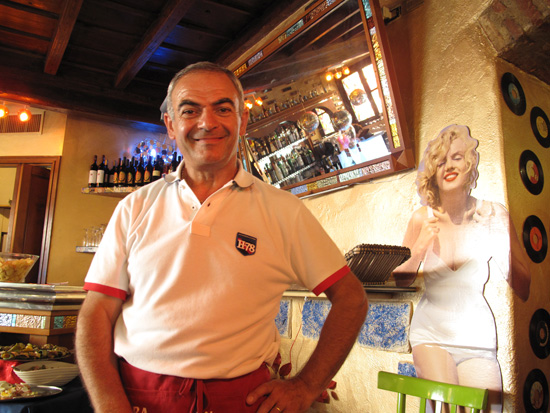
Two men walked in and took the table right next to me. As I’ve found here in general, space is tight and so are tables. People sitting NEXT to you might as well be eating WITH you. We started chatting and comparing our purchases. Mako and Ma Qing Sheng are son and father, here for two months from China. They had purchased and showed me a set of an elaborate, engraved serving spatula and fork, with matching appetizer forks. I showed them the old book and hat form I bought. Piero, our host, joined the conversation and pretty soon we were all one big, happy family in conversation.
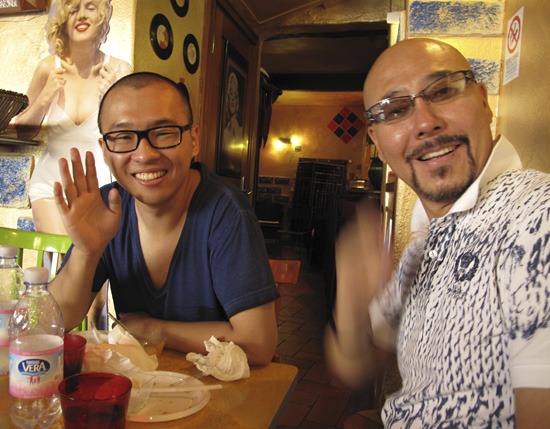
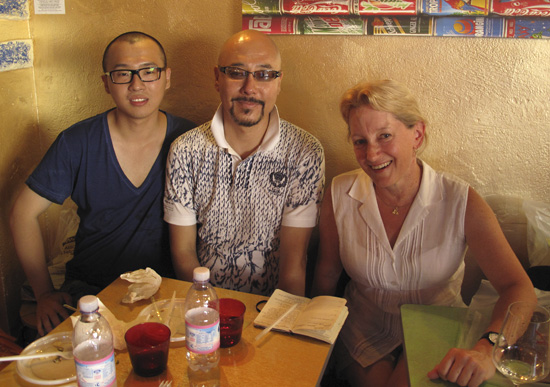
Ma Qing Sheng liked the hat form and I told him I’d take him to the seller so he could buy one. We paid our bills for lunch. Piero gave me a European kiss goodbye and we started walking and talking. I was amused by the absurd unlikelihood of the situation: being in Italy and carrying on in Italian with two Chinese men. (The little bit of Chinese I know was buried too deep in the recesses for any access or assistance as we chatted.)
Ma Qing Sheng picked out one of the very sculptural forms, and the father and son playfully modeled some of the vintage hats on display (probably to the chagrin of the seller, but she had just sold another hat form, so wasn’t putting up a fuss). Mako and his father and I exchanged contact information and we may get together for dinner sometime in the next month.
These unlikely moments will make me smile and sparkle for years to come…

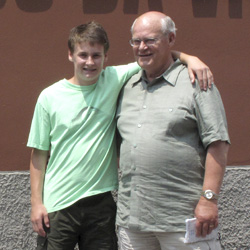
by Maureen | Jun 28, 2010 | Cheese, Food!, Incredible Locations, Journal, Meals, People, Photos, Varenna
How do you give a 13-year-old a whirlwind overview of Milano and other spots in Italy?
I had grown up picking rocks off of Earl’s parents’ waterfront on Three Tree Point, just down from the house I have in Seattle now. (In other words, he’s known me since I was born.) So when Earl decided to take his grandson, Matthew, on a tour of Italy, and knowing that I’m here in Milano, he got in touch with me and we started planning the whirlwind. By the time the trip was only a week away, Earl wrote to say they were “counting the hours”.
The two travelers arrived at Milano Malpensa Airport, jet-lagged but excited. We caught the train into the city, with one minute to spare.
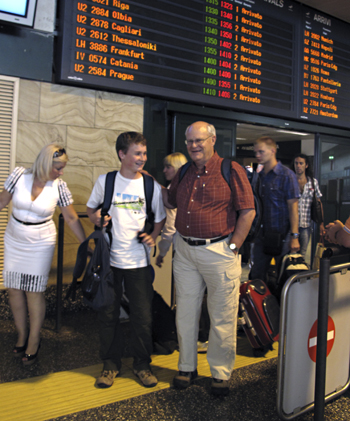
Like Hannah and Zibby two days before, Earl and Matthew’s first stop, with mere 21-pound packs still on their backs, was the Spezia Milano Pasticceria. They needed a little something to take to their hotel room and picked out a dozen sweet treats. (The best in town.)
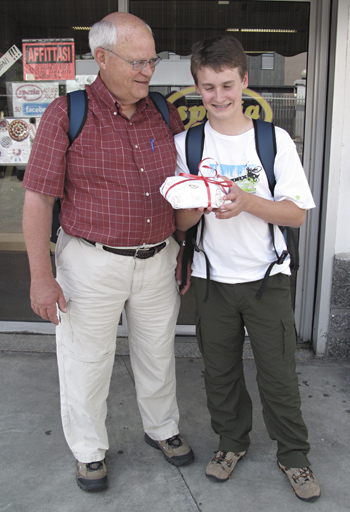
The guys needed a break after their long travels, and a little freshening up. We met up a couple of hours later when they came over to my apartment just 2 blocks away to “skype” family back home. Then we walked up the canal, Naviglio Pavese, to a pizza restaurant with a wood-fired oven. I don’t know what was so funny, but Matthew enjoyed his 5 cheese pizza. Much of it was packed home though, and ended up in my frigo (and made a high-fat breakfast for me the next day).
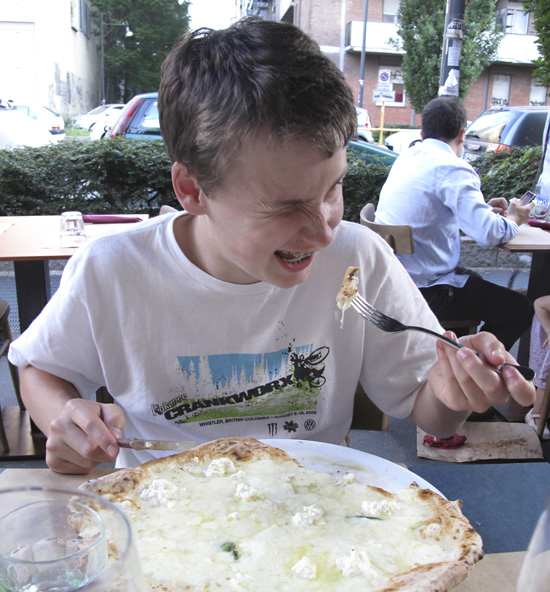
Earl and I shared an antipasta plate of mixed cheeses and meats, then a pizza of prosciutto, mushrooms and artichoke hearts.
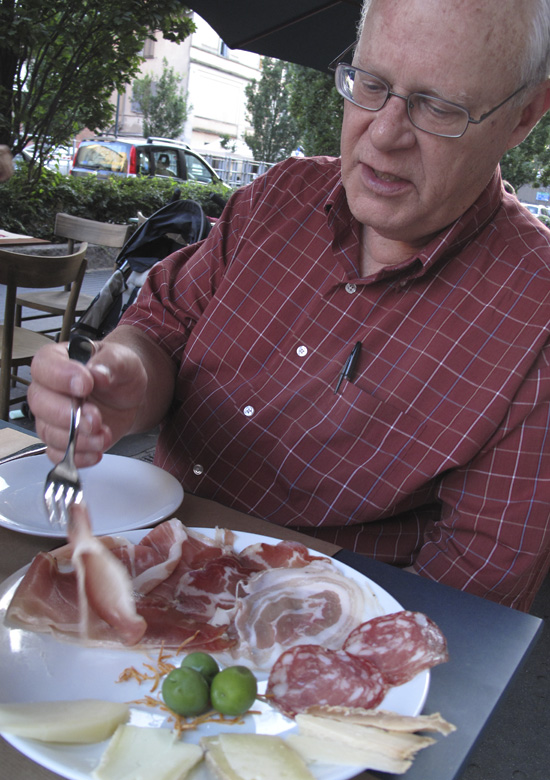
Still recovering from the trip, “The Boys” called it a night early without the evening stroll along the canal (to the gelato shop), and headed back to their hotel for a good, long night’s sleep.
In the morning, having missed the breakfast part of the “bed & breakfast”, they came to my apartment for made-to-order, prosciutto/grana/peperoni/cipolla omelettes with bread, jam, blood orange juice and strong coffee. Once they had been fueled for the day, we headed for the subway.
It was a day to scout for Leonardo around town; he had lived in Milano for 20 years as a young man and left his mark across the city. Our first stop was the Castello Sforzesco, an impressive moat-encircled castle in the center of town. From there we moved on to The Museum of Science and Technology and its Leonardo da Vinci exhibit.
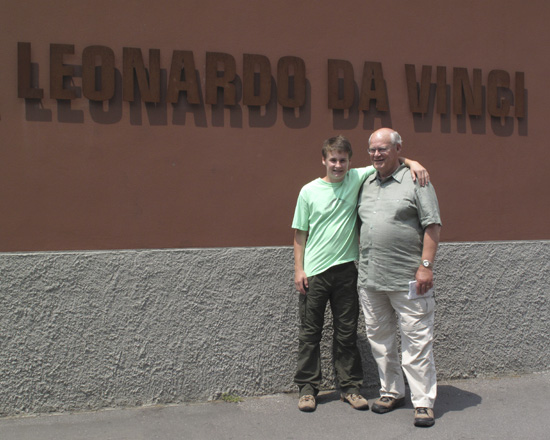
We saw some incredible models representing the ideas in Leonardo’s Codex Atlanticus!
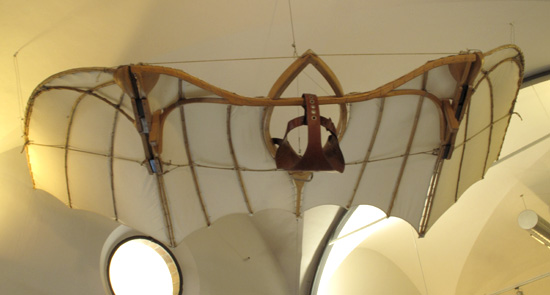
.
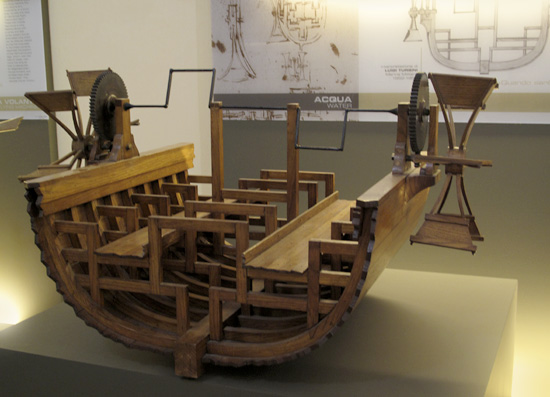
.
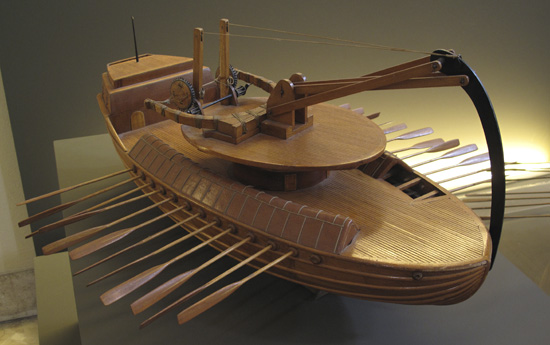
We had 3:30 tickets for The Last Supper and needed to check in a half hour beforehand. Their tours are very precise in their beginnings and endings so that they can best control the atmosphere within the chamber that hosts the fragile mural. To actually SEE the original painting, the inspiration for so many reproductions and college lectures, is an experience to add to a lifetime.
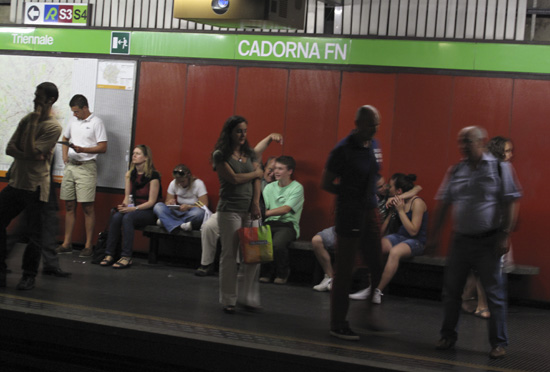
Earl and Matthew were both spent after our sightseeing. We each wolfed down a panino of prosciutto, brie and “red mayonnaise” then headed back to the subway. I was heading north to buy our train tickets for the next day, and they were going to test their navigational skills and get themselves back to their hotel. (Matthew had great fun later trying to convince me that they had gotten lost and had been wandering around for hours.)
We regrouped later for evening skype sessions with the folks back home. (At 6:00 pm here, it’s 9:00 am on the U.S. West Coast.)
The big question was “where shall we go for dinner?” With so many options, I wavered in my recommendation, but kept thinking about octopus and potatoes at the Carlotta Café south along the canal. I wasn’t sure how adventurous Matthew would be, but we went anyway, and took a cab since neither the subway nor our feet would get us there easily.
Dinner was DIVINE. If you ever want a good meal in Milano, head to the Carlotta Café! Matthew ordered gnocchi with speck, (like a lightly smoked prosciutto) and rucola (arugula) in a fabulous, creamy sauce.

Apparently, Matthew really liked the sauce! (Matthew! I can’t believe you did that!)
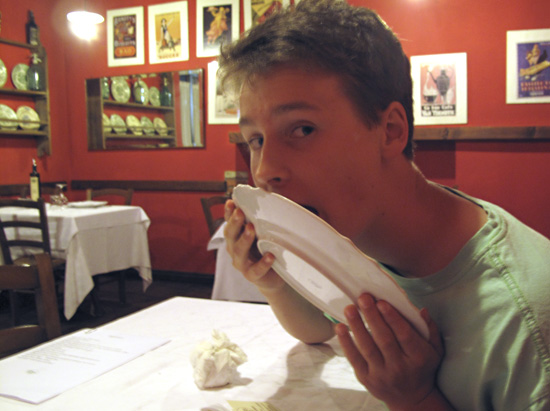
Earl and I ordered the evening special, a 7-course, fish-based meal that kept the food coming all night. At our first urging, Matthew took a little taste of the fresh-caught anchovies and he was hooked from then on. He quickly swooped in on a half dozen of the slim, silvery filets, then scooped up a portion of the much-anticipated octopus and potatoes. I was pleased by his willingness to sample the seafood variety.
Our 29 Euro-per-person meal included:
– “Paper Music” bread, hot, drizzled with olive oil and sprinkled with salt
– Piovra tiepida con patate e olive (Octopus with potatoes, olives and olive oil)
– Alici marinate (Fresh anchovies on a bed of rucola)
– Carpaccio di spada (thin slices of raw swordfish)
– Ostriche (Raw oysters)
– Paccheri all’isolana (pasta, tomato, tuna, basil)
– Spaghetti con bottarga (spaghetti with grated, dried tuna roe)
– Branzino vernaccia (Roasted branzino fish with olives)
– Mirto (an after-dinner liqueur from myrtle leaves and berries)
– Pardule (a star-shaped, pastry desert from Sardegna)
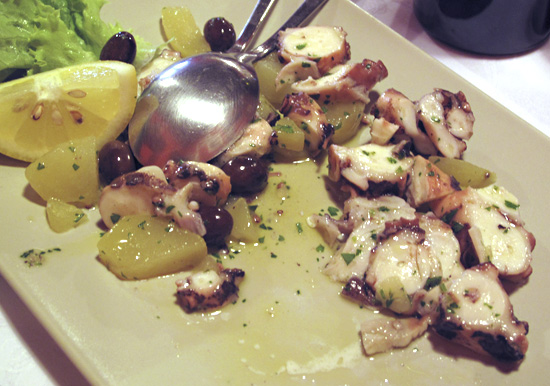
We ordered a nice, chilled bottle of Vermentino di Sardegna vino bianco to go with our seafood.
By the end of the evening we were having quite the time chatting with Erik, our wonderful waiter. When other restaurant patrons ordered a roasted, suckling pig, Erik brought it by to show us. And when it was time to leave, we met the chef/owners and the others in the kitchen, complimenting them on our fantastic meal.
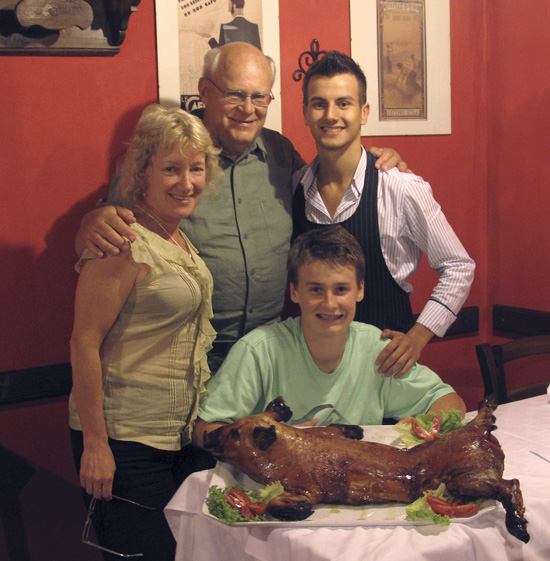
Carlotta Café
Alzaia Naviglio Pavese, 274
20142 Milano
Tel: 02-89546028
The next day we hopped the train northeast, to the town of Varenna, along the eastern shore of Lago di Como (Lake Como). Earl and Matthew were scheduled to meet with a travel group at 5:00 that evening to continue their whirlwind tour. Since I hadn’t seen Varenna before, I accompanied them on the train trip and to their steep hillside room-with-a-view. From their balcony, they looked almost due west to Bellagio (hidden by the 3 tall cypress trees), and north to the town of Varenna.
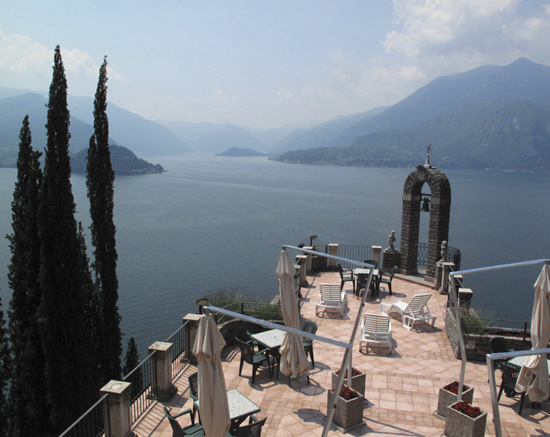
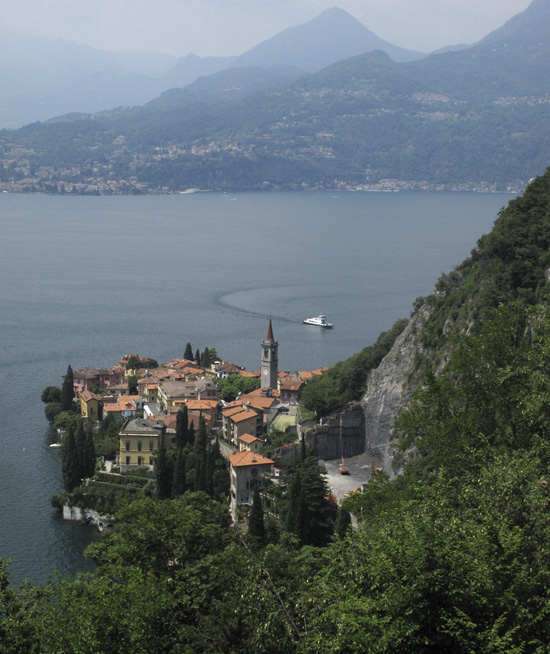
We had a little wander around the town and a lunch by the lake shore.
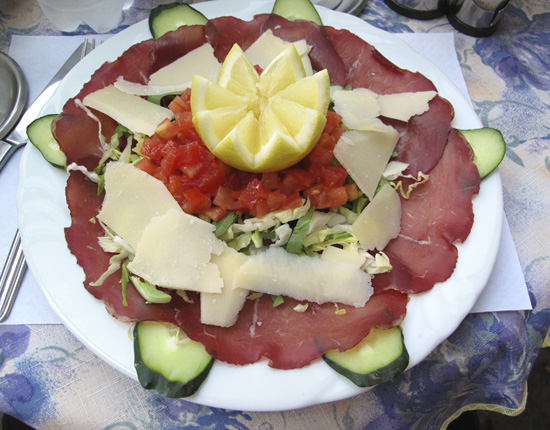
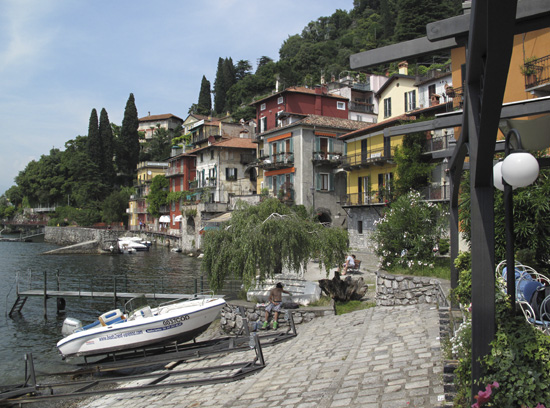
After lunch, we walked just around the bend for a treat of pistacchio, coconut and vanilla gelati, which we ate while leaning on the railing looking out over the water. We said our goodbyes, gave each other hugs, and then went our separate ways for our own exploration.
We had two very full, delicious and beautiful days! What an introduction for Matthew – nicknamed “Mateo” – to the sights and food of Italy. I’ll be curious to know what his highlights are.









































































































